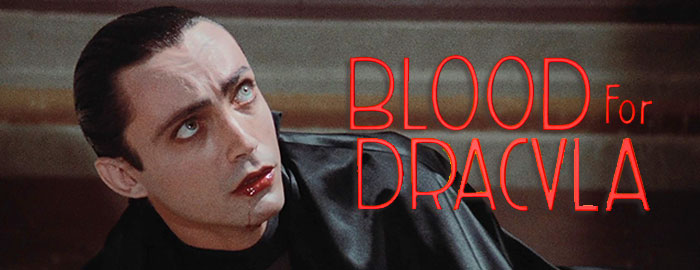
Color, 1974, 103 mins. 6 secs.
Directed by Paul Morrissey
Starring Udo Kier, Joe Dallesandro, Vittorio De Sica, Maxime McKendry, Arno Jürging, Stefania Casini, Milena Vukotic, Dominique Darel, Silvia Dionisio
Severin Films (UHD & Blu-ray) (US R0 4K/HD), Cinema Cult (Blu-ray & DVD) (Australia R0 HD/PAL), Image Entertainment (DVD) (US R1 NTSC) / WS (1.85:1) (16:9), Criterion (DVD) (US R1 NTSC) (1.85:1)
Audiences 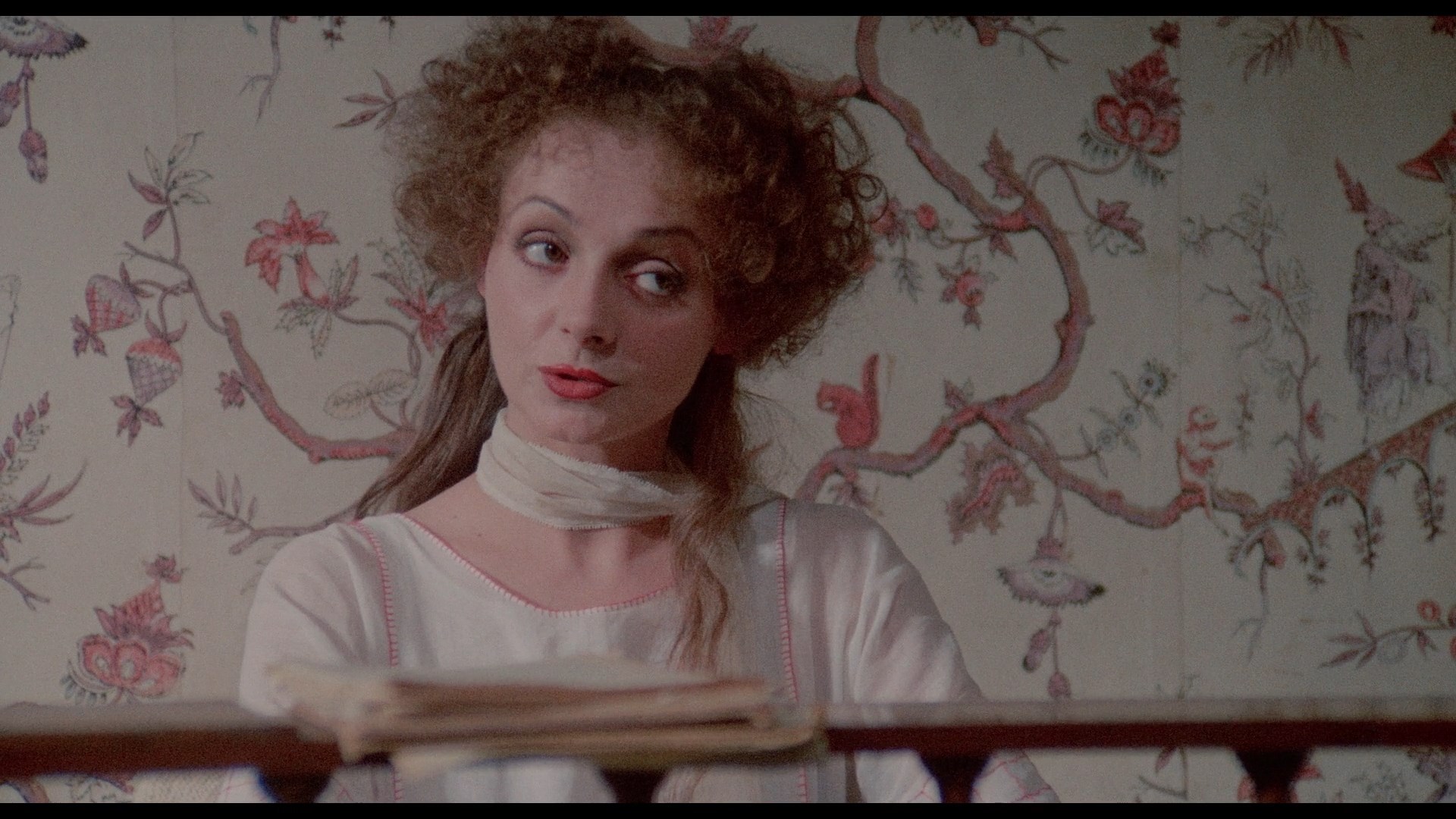 had no idea what hit them when they
had no idea what hit them when they 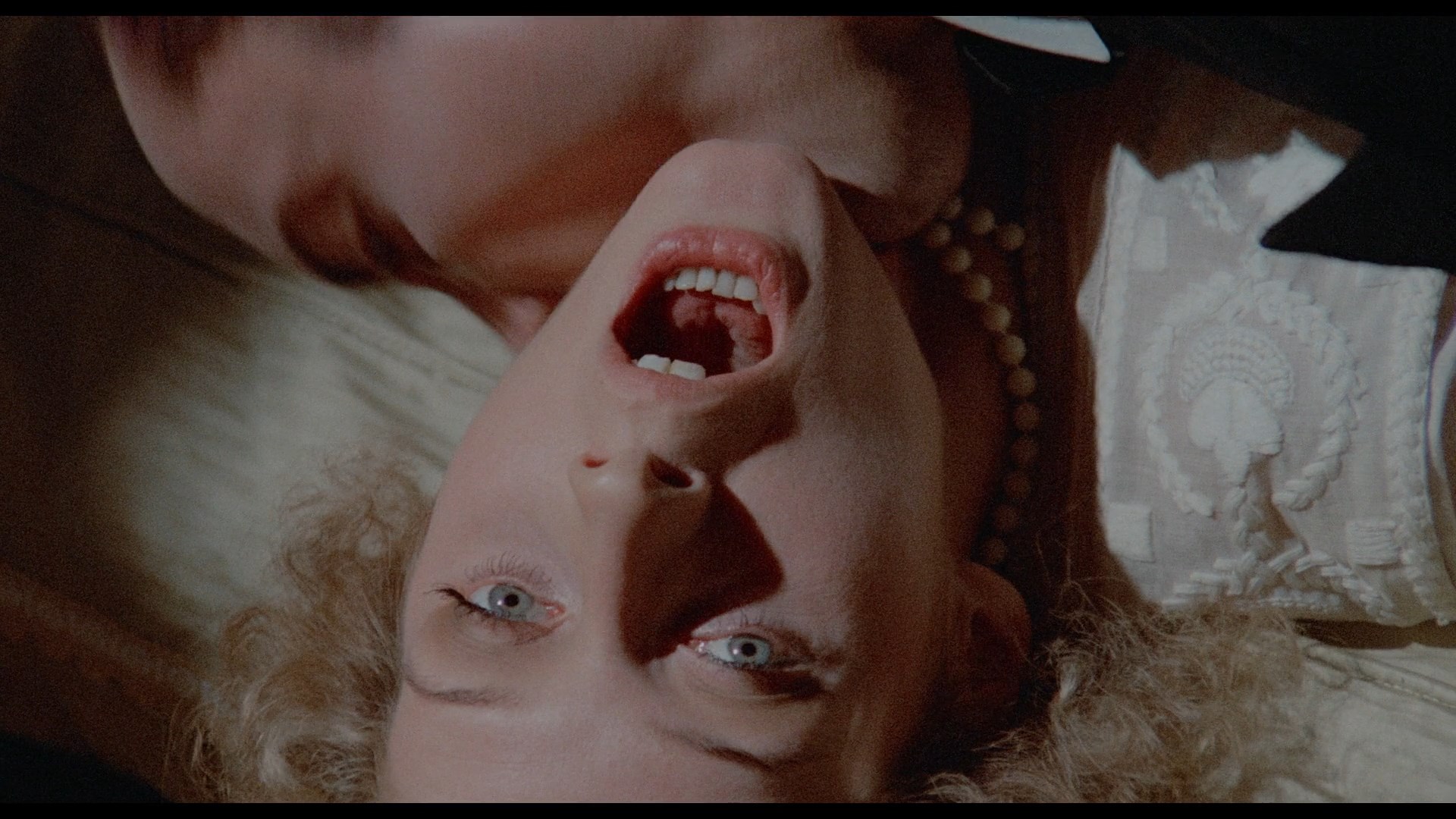 were blindsided by two of the most outrageous cult films of the 1970s, a pair of opulent and hilariously graphic spins on classic movie monsters. The first, Flesh for Frankenstein (released in the U.S. as Andy Warhol's Frankenstein), was a wild 3-D extravaganza of quotable lines and eye-popping innards, so three of its stars stuck around with director Paul Morrissey to jump right into a follow-up film on the spot. Blood for Dracula (originally known as Andy Warhol's Dracula, though Warhol had essentially zilch to do with either film apart from hanging out on the set and taking photos) featured a far more structured and witty script, also shot in Italy and taking full advantage of the locations that one would normally expect in something by Visconti. Like its predecessor, this was released with an X rating in the U.S. (both films have plentiful nudity but aren't sexually explicit); however, its gore level here is more carefully measured, which might sound odd for a film that has several minutes of Udo Kier puking blood into a bathtub. With its insane mishmash of accents and surprisingly potent theme of
were blindsided by two of the most outrageous cult films of the 1970s, a pair of opulent and hilariously graphic spins on classic movie monsters. The first, Flesh for Frankenstein (released in the U.S. as Andy Warhol's Frankenstein), was a wild 3-D extravaganza of quotable lines and eye-popping innards, so three of its stars stuck around with director Paul Morrissey to jump right into a follow-up film on the spot. Blood for Dracula (originally known as Andy Warhol's Dracula, though Warhol had essentially zilch to do with either film apart from hanging out on the set and taking photos) featured a far more structured and witty script, also shot in Italy and taking full advantage of the locations that one would normally expect in something by Visconti. Like its predecessor, this was released with an X rating in the U.S. (both films have plentiful nudity but aren't sexually explicit); however, its gore level here is more carefully measured, which might sound odd for a film that has several minutes of Udo Kier puking blood into a bathtub. With its insane mishmash of accents and surprisingly potent theme of 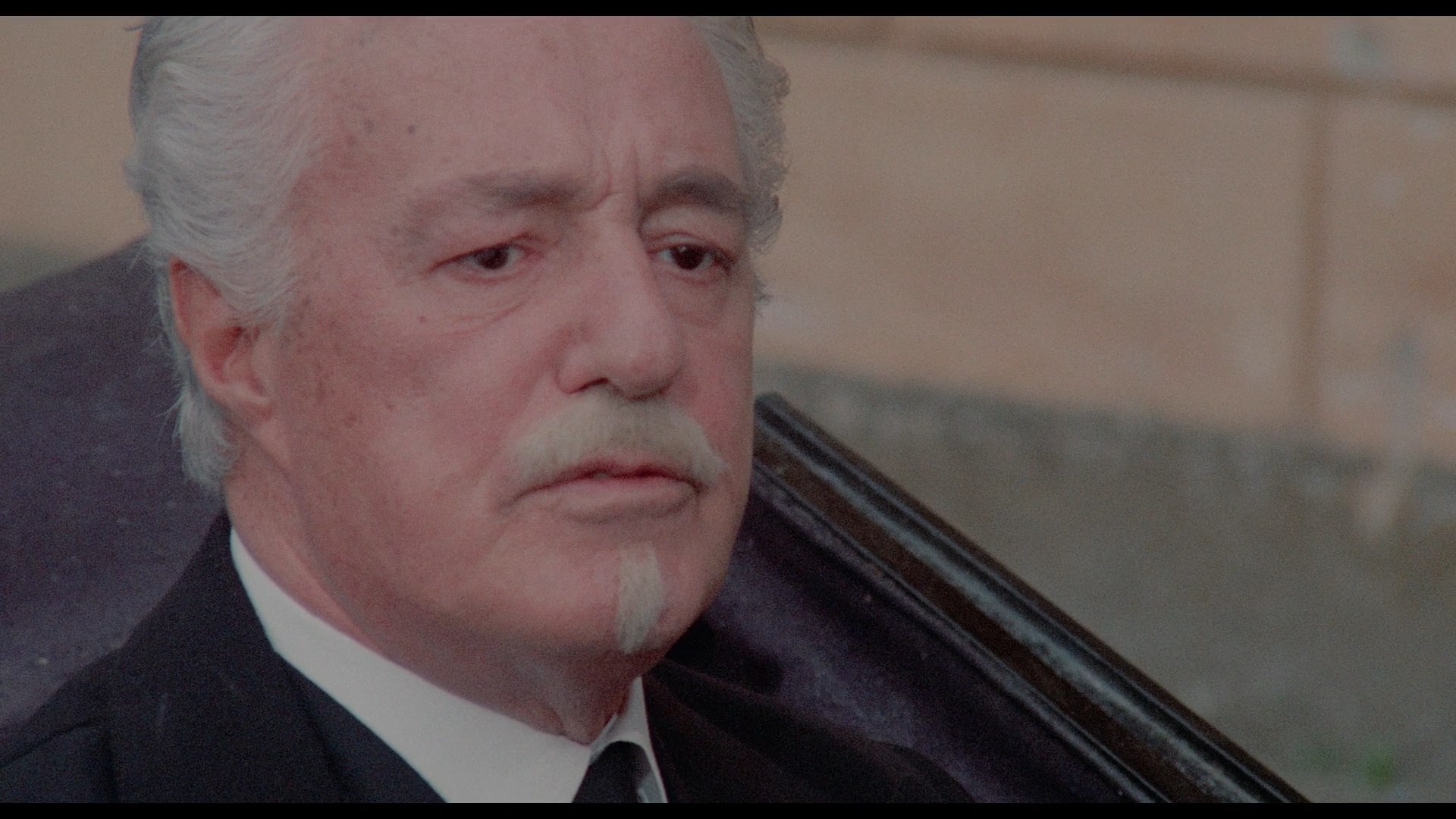 rotting aristocracy
rotting aristocracy 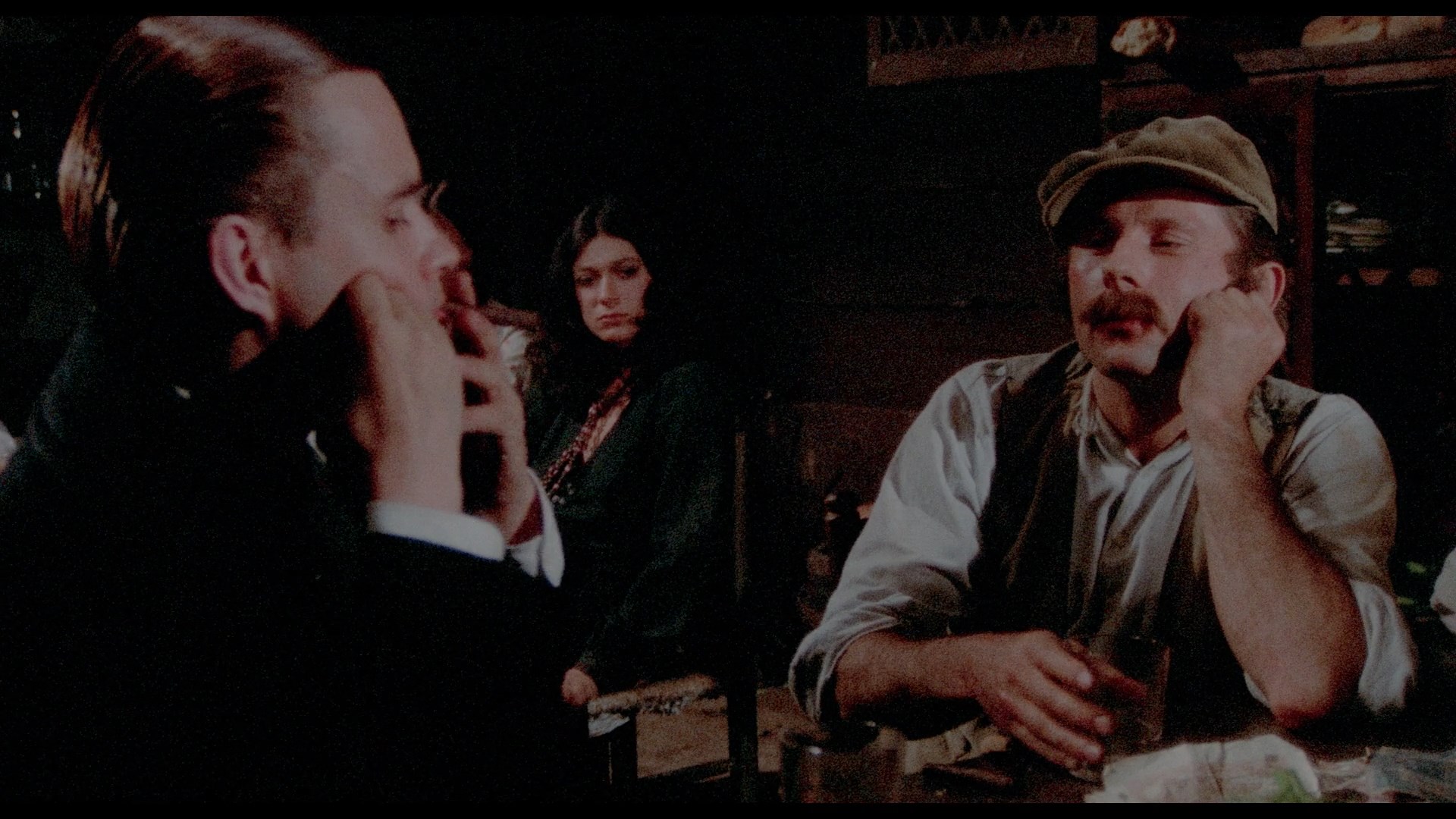 versus the irate working class, the film became one of the most notable horror films of the decade-- and there's still nothing else out there remotely like it.
versus the irate working class, the film became one of the most notable horror films of the decade-- and there's still nothing else out there remotely like it.
Unable to find a sustainable source of virgin blood due to his notoriety in Romania, Count Dracula (Kier) puts his beloved sister to hibernate in the family crypt and, following the advice of his cantankerous familiar Anton (Jürging), packs up his coffin to go look for a fresh supply in Italy. A good prospect arrives with the financially ailing Di Fiore family, who have four daughters: prim Esmeralda (Vukotic), free love practitioners Saphira (Darel) and Rubina (Suspiria's Casini), and the young and naive Perla (Terror Express' Dionisio). Their parents (De Sica and McKendry) can only afford to retain one servant now, the Bolshevik-sympathizing Mario (Dallesandro), who spends his off hours bedding both Rubina and Saphira. Upon arrival, Dracula and Anton first settle into an inn but score an invitation to stay with the Di Fioris, who are eager to marry off one of their girls to boost their fortune again. Of course, the increasingly frail Dracula is really more 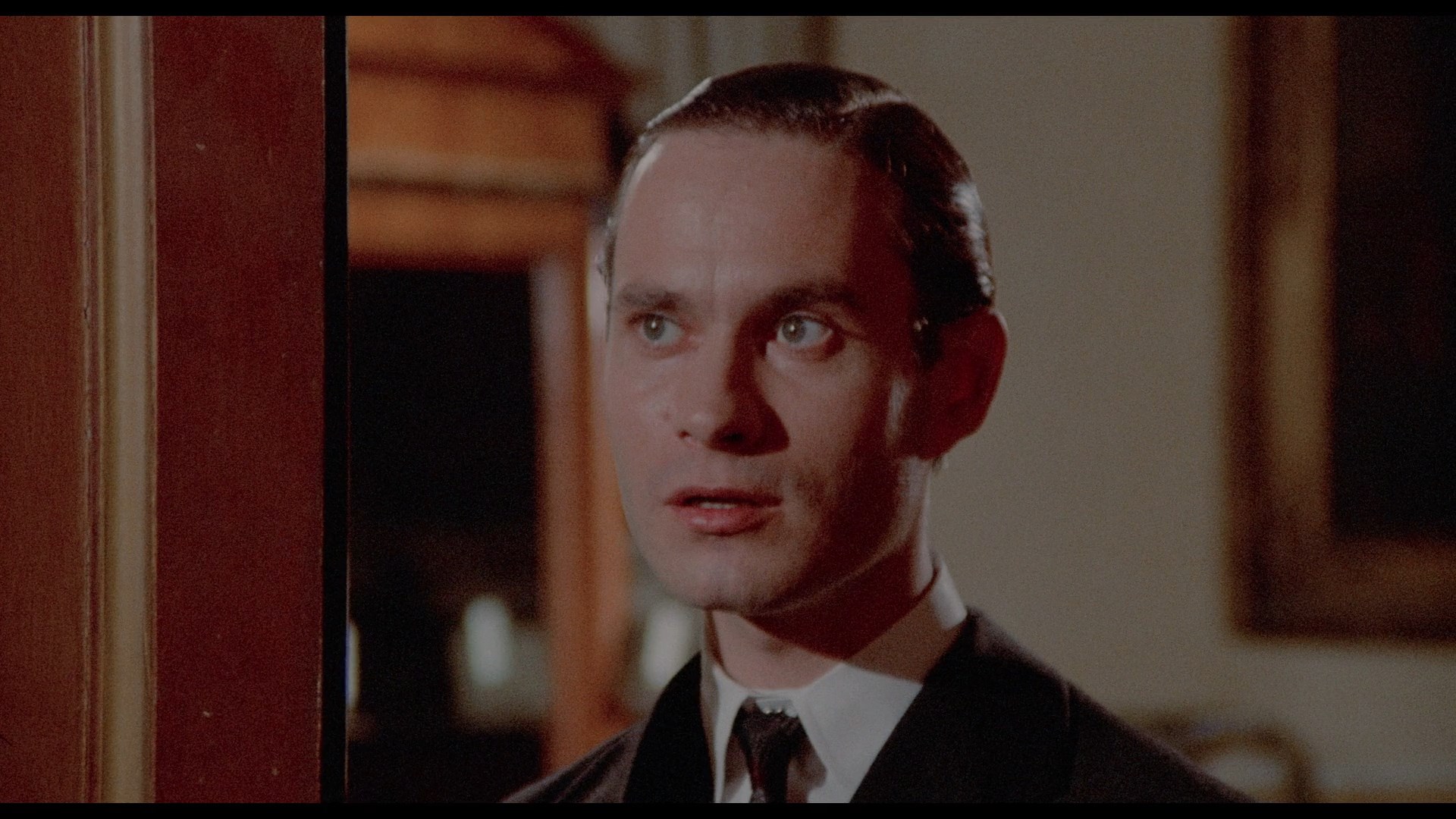 interested in the daughters' blood supply,
interested in the daughters' blood supply, 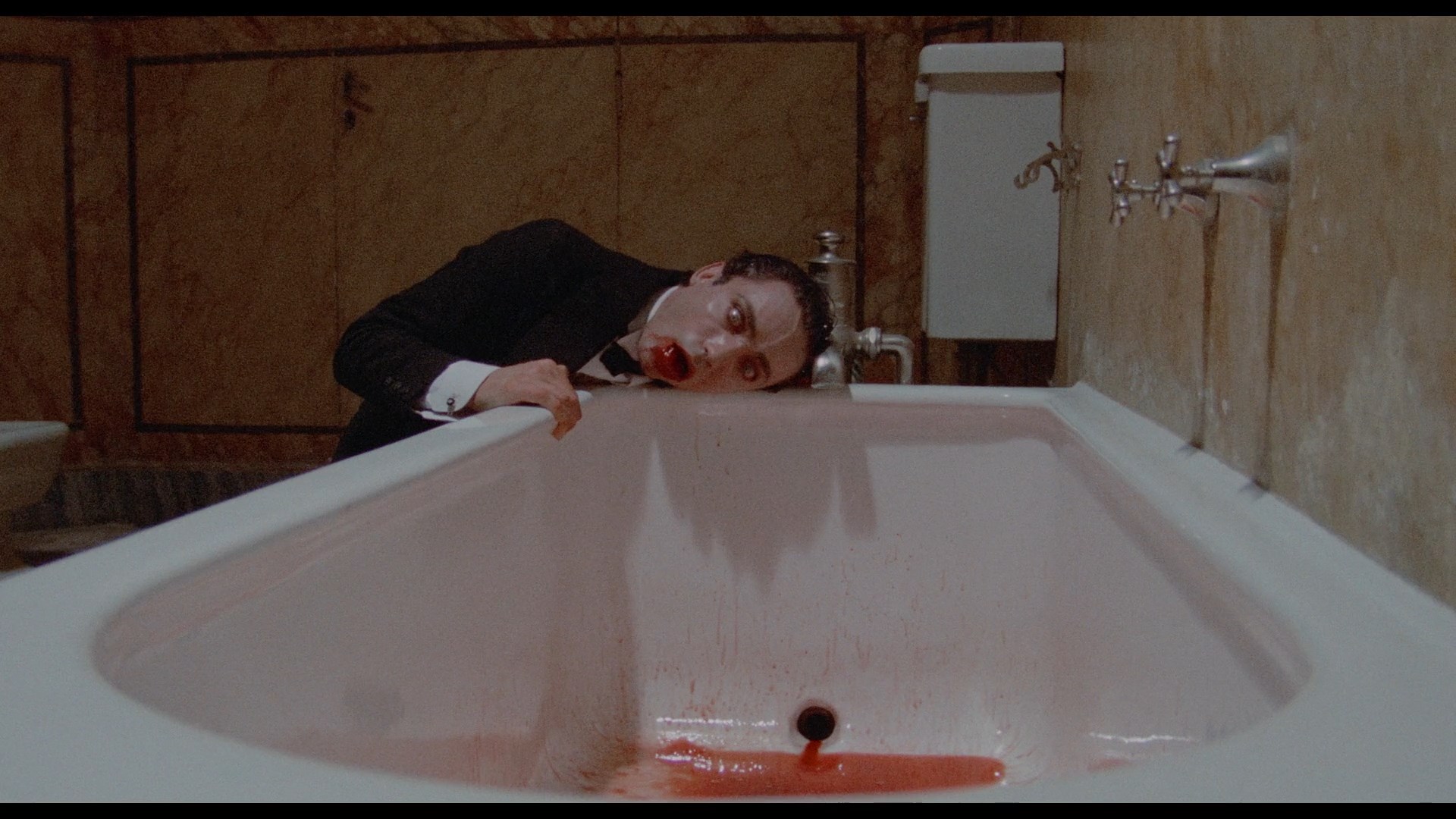 which turns out to be far more of a challenge than he'd imagined.
which turns out to be far more of a challenge than he'd imagined.
Though definitely not for all tastes, Blood for Dracula is really a perfect film of its kind. Gifted cinematographer Luigi Kuveiller (Deep Red) gets a lot of mileage out of the primary location, the familiar Villa Parisi (a.k.a. Villa Borghese) in Rome, recognizable from everything from Hatchet for the Honeymoon to Patrick Still Lives. Of course, the cast is insane and yet somehow completely on point, with Kier excelling as a desperate upper class vampire trying to fight the changing tide swallowing up his entire class; a hilarious scene stealer in Frankenstein, Jürging manages to match him once again as his haughty blood procurer whose plans keep backfiring disastrously. Having so many Italian and French actors delivering their lines with such a clash of accents and styles would spell disaster for most movies, but here it works; the legendary De Sica is particularly fun rolling the lines around on his tongue, and of course it's great to have a rare opportunity to hear Casini speaking English in her own voice for once. Often overlooked but wonderful here is McKendry, However, the most valuable player here might be composer Claudio Gizzi, a Visconti veteran who delivers a remarkably haunting and melancholy score that advances on his already brilliant work on Frankenstein. 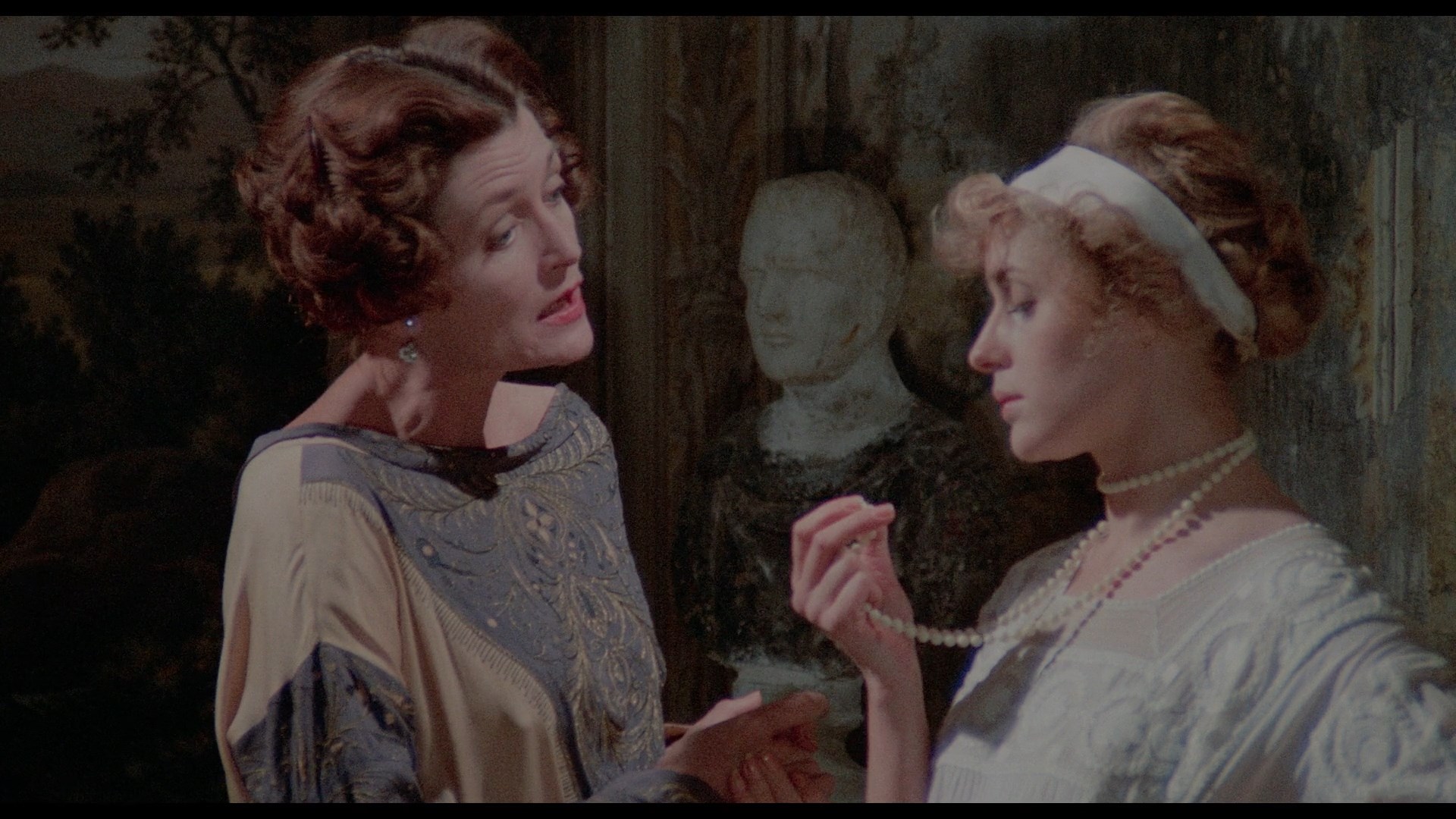 On
On 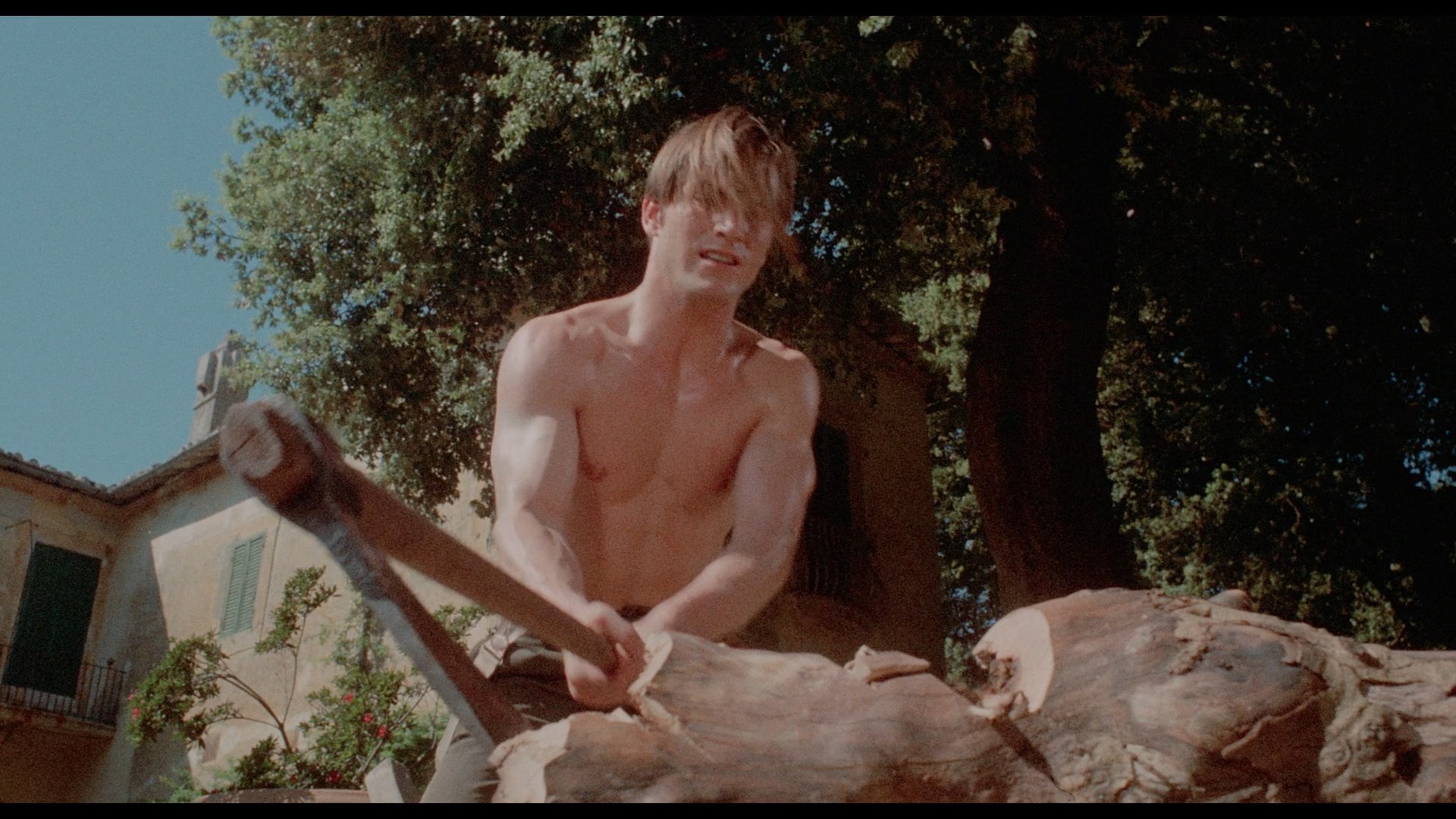 top of that, the film is still extremely funny, not just in its most-quoted moments like the immortal "The blood of these whooores is killing me!" and the pronunciations of "wergin" but in great throwaway bits like "I am sure they're religious; they have a very nice house" and a great cameo by Roman Polanski (who was shooting What? nearby) and his frequent writer Gerard Brach playing a bar game with Jürging.
top of that, the film is still extremely funny, not just in its most-quoted moments like the immortal "The blood of these whooores is killing me!" and the pronunciations of "wergin" but in great throwaway bits like "I am sure they're religious; they have a very nice house" and a great cameo by Roman Polanski (who was shooting What? nearby) and his frequent writer Gerard Brach playing a bar game with Jürging.
Initially released in the U.S. by the notorious mob-connected Bryanston Distributing, Dracula had a fairly spotty history on VHS with its X rating keeping the clamshell release from Video Gems off the shelves of the more family-friendly stores back in the '80s. A heavily edited version of the film (along with Frankenstein) aired occasionally in the '90s on USA Up All Night, but with the rights reverting back to Morrissey, it ended up getting the prestige treatment as part of the Criterion Collection on laserdisc in 1996 and later on DVD in 1998. Though not anamorphic, the transfer was okay for its time and completely uncut, plus it featured a fun audio commentary splicing together comments from Morrissey and Kier. That same track was used again for a better DVD reissue in 2005 from Image Entertainment, which featured an improved anamorphic transfer along with a batch of production stills (24m50s) with Morrissey commentary and an early 2.35:1 screen test (4m11s) with Frankenstein's Srdjan Zelenovic as Dracula, featuring Morrissey commentary as well.  An unauthorized Australian release came along later on Blu-ray and DVD from Cinema Cult, porting over the same extra from the Image disc and featuring what appears to be an upscale of
An unauthorized Australian release came along later on Blu-ray and DVD from Cinema Cult, porting over the same extra from the Image disc and featuring what appears to be an upscale of 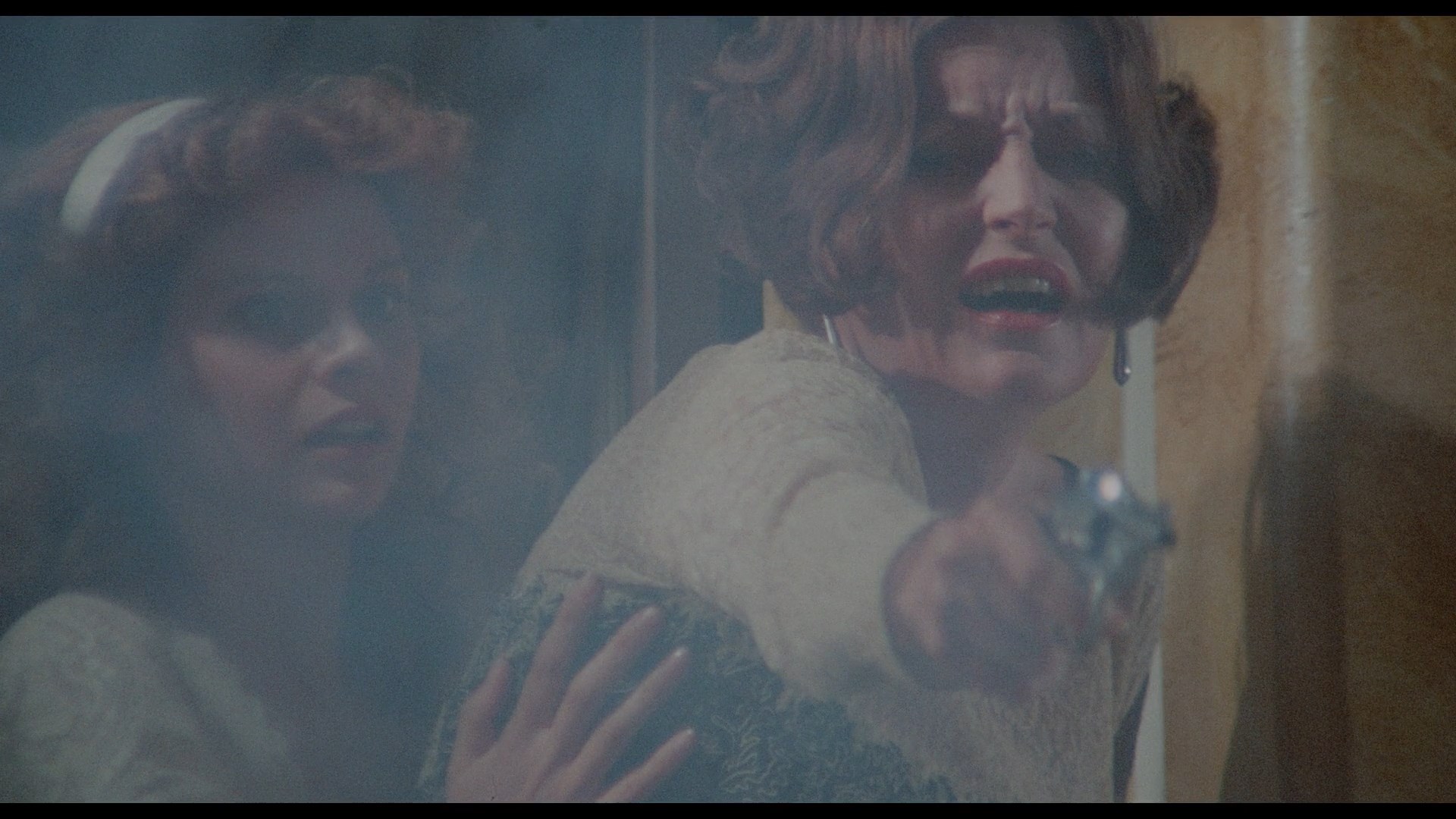 the same scan.
the same scan.
Given Morrissey's worldwide ownership of the film and the very singular nature of his personality, it seemed like an official release of the film after the Image days might never happen. Fortunately the tide turned in 2021 with a deluxe three-disc set from Severin Films containing a UHD (feature plus two trailers), a stacked Blu-ray, and a remastered soundtrack CD featuring the expanded version of Gizzi's classic score. The UHD looks especially strong with very deep, rich blacks giving the film a nice atmospheric feel throughout, but the Blu-ray is no slouch either with nice grain and excellent warm tones throughout. (It's worth noting the initial review copies sent out had a faulty color space setting but the finished product is correct.) The DTS-HD MA English 2.0 mono track also sounds pristine and features optional English SDH subtitles.
The copious video extras being with "Trans-Human Flesh And Blood" (35m35s), a 2016 video interview with Morrissey who's in his usual form here chatting about his directing days and repeatedly bemoaning the death of cinema while repeatedly noting, "The world is a toilet." Be sure to watch the whole thing since he starts trash talking some of his most famous collaborators including Warhol, Lou Reed, Dudley Moore, and so on, as well as sad digressions about Nico and Rodney Harvey. "Rubinia’s Homecoming" (17m59s) is an interview and location walking tour with a very cheerful and charismatic Casini revisiting the villa and sharing memories about her costars, goofing around in a great bit in that unmistakable bathroom and noting how Kier was the only real professional of the cast members she worked with versus the other youngsters basically having fun. 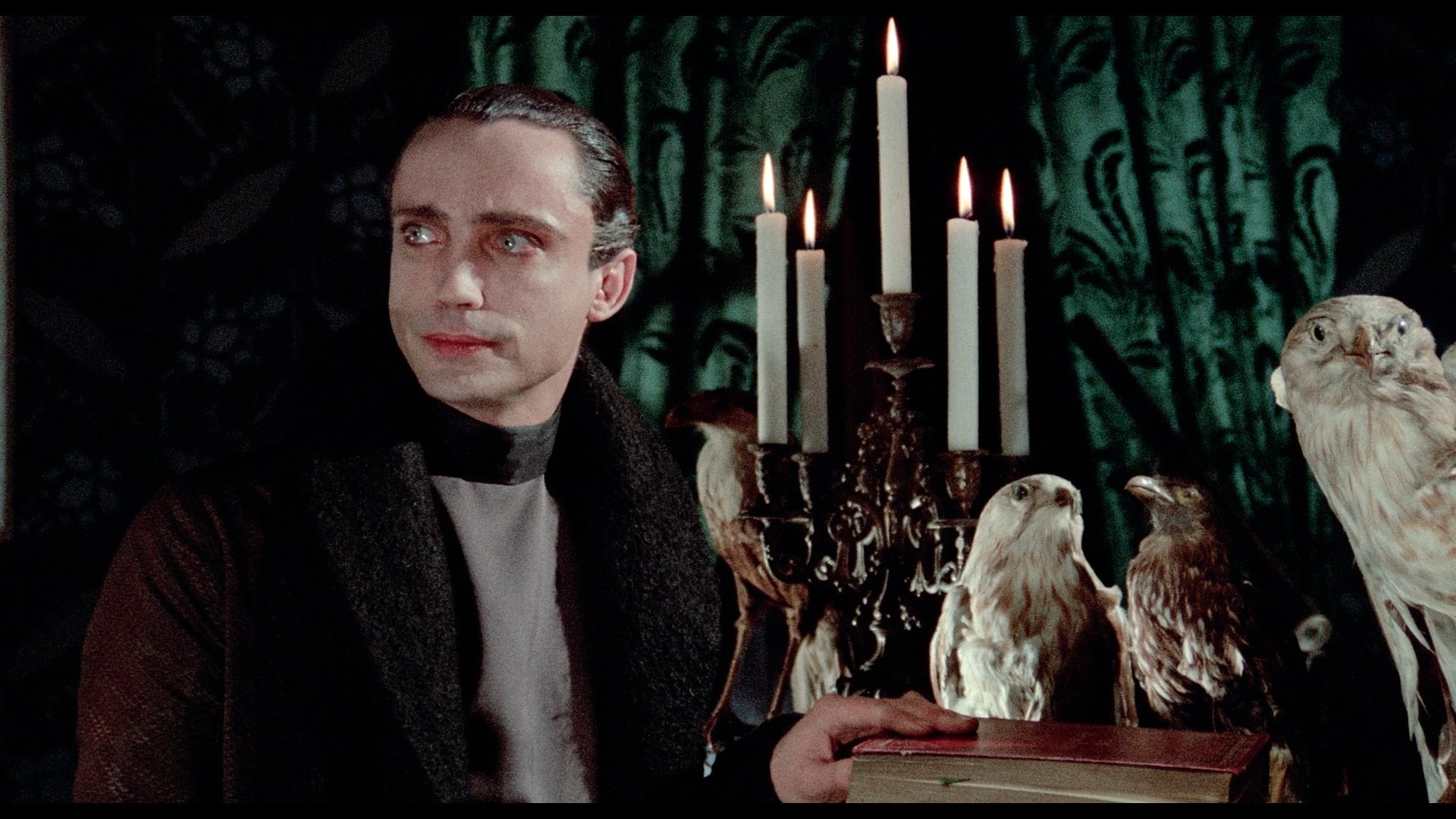 "Blood For Udo" (18m56s), Kier is also in fine form chatting about his quickly truncated melancholy after
"Blood For Udo" (18m56s), Kier is also in fine form chatting about his quickly truncated melancholy after 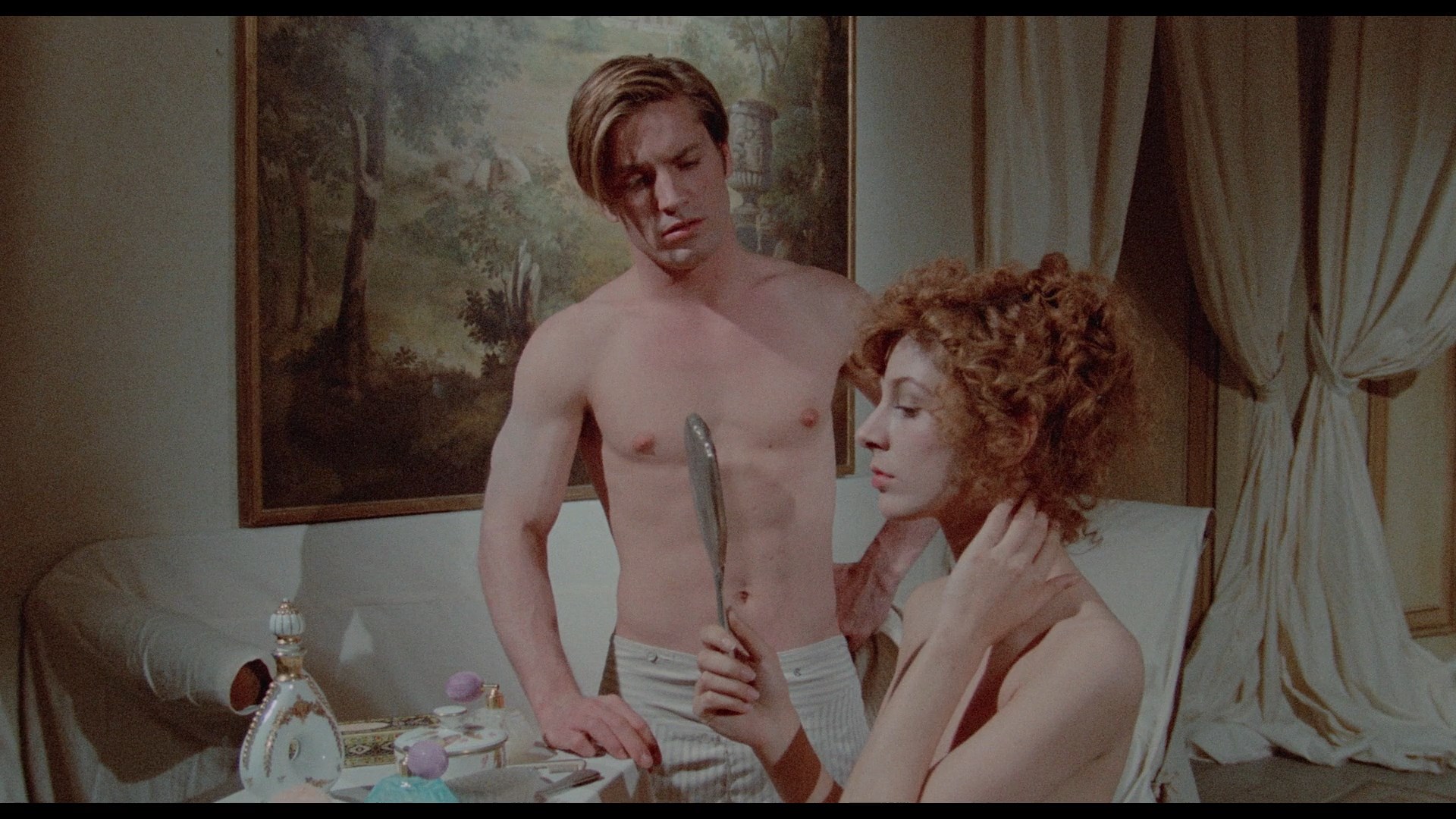 finishing Frankenstein, the abrupt need to lose ten pounds within a week, the porn movie being shot on the premises at the same time, and some of his other vampire-related roles. (Don't miss the bit about Spermula or his jonesing for a cigarette.) Dallesandro is up next in "Little Big Joe" (28m14s) complete with a whole chronicle of his first encounter with Morrissey (and Warhol) and their early films together (including Lonesome Cowboys and the Flesh trilogy), his return to Morrissey with the two horror films on the heels of The Gardener, and the controversy over the involvement of Antonio Margheriti, who was credited as the director on the Italian releases of both films but was only involved in a limited capacity for second unit work. He also goes into the relationship he forged with Casini on the film and some of the other films he made when he decided to stick around in Italy for a bit.
finishing Frankenstein, the abrupt need to lose ten pounds within a week, the porn movie being shot on the premises at the same time, and some of his other vampire-related roles. (Don't miss the bit about Spermula or his jonesing for a cigarette.) Dallesandro is up next in "Little Big Joe" (28m14s) complete with a whole chronicle of his first encounter with Morrissey (and Warhol) and their early films together (including Lonesome Cowboys and the Flesh trilogy), his return to Morrissey with the two horror films on the heels of The Gardener, and the controversy over the involvement of Antonio Margheriti, who was credited as the director on the Italian releases of both films but was only involved in a limited capacity for second unit work. He also goes into the relationship he forged with Casini on the film and some of the other films he made when he decided to stick around in Italy for a bit.
"Conversation With A Vampire" (18m50s) features an audio interview with Vukotic about her own career in the mid-'70s in Italy after working for directors like Bertolucci and Fellini, her admiration for Morrissey, her research into vampirism, and her thoughts on her character. In "Bloodthirsty" (14m38s), assistant director Paolo Pietrangeli goes into his own enthusiasm for Morrissey's Trash, the whole Margheriti thing, the chauvinism that was prevalent at the time, the dirty nickname the crew had for Dallesandro, his personal taste in supernatural literature, and the surprisingly conservative demeanors and lifestyles of Morrissey and Warhol at the time. Art director Gianni Giovagnoni appears next in "Black Cherry" (26m56s) noting how both films were essentially shot continuously with the same crew, though this one offering a different experience thanks to moving outside of Cinecitta and focusing more on real buildings and landscapes with 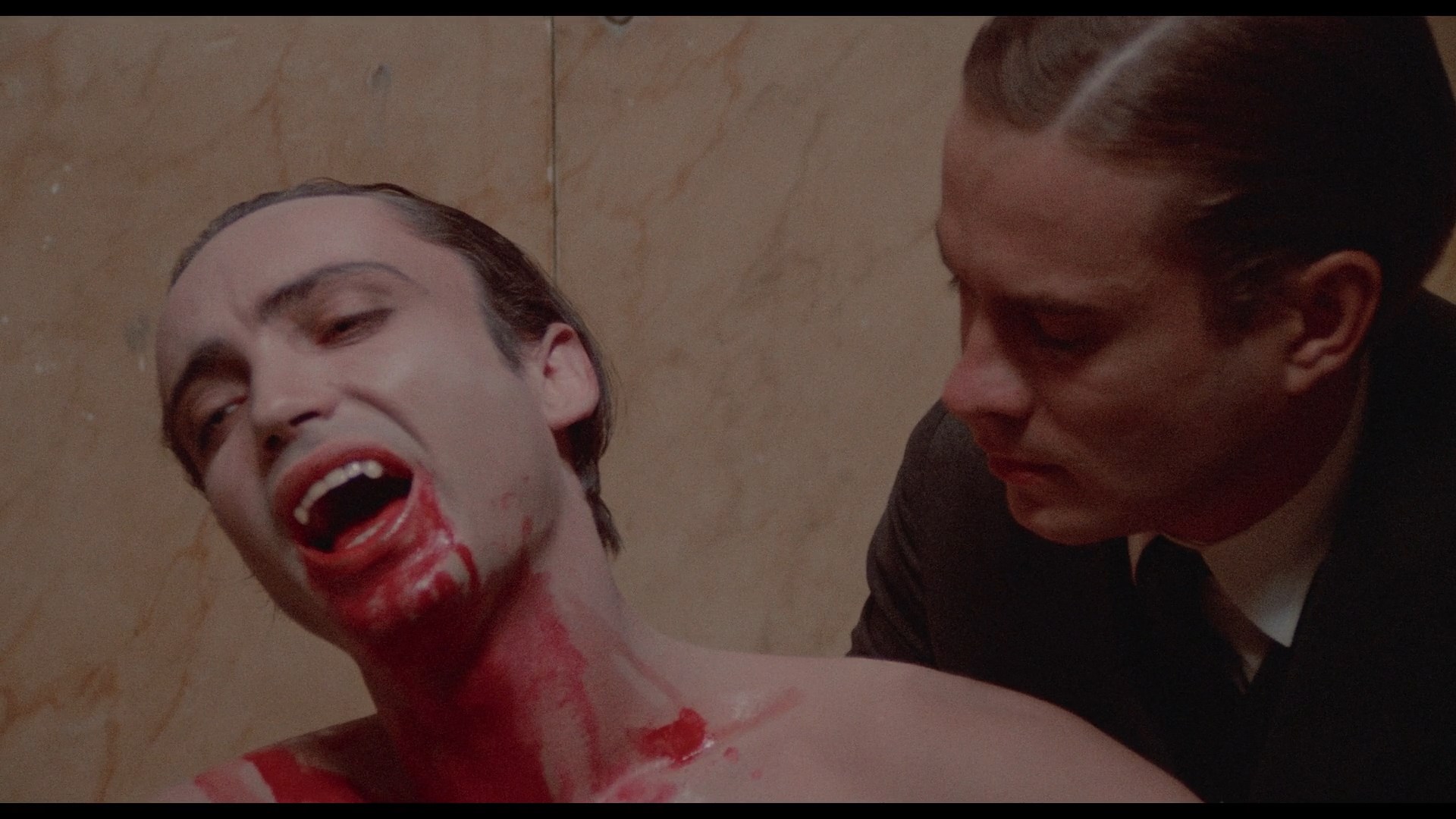 the villa being used as much as possible. Stephen Thrower turns
the villa being used as much as possible. Stephen Thrower turns 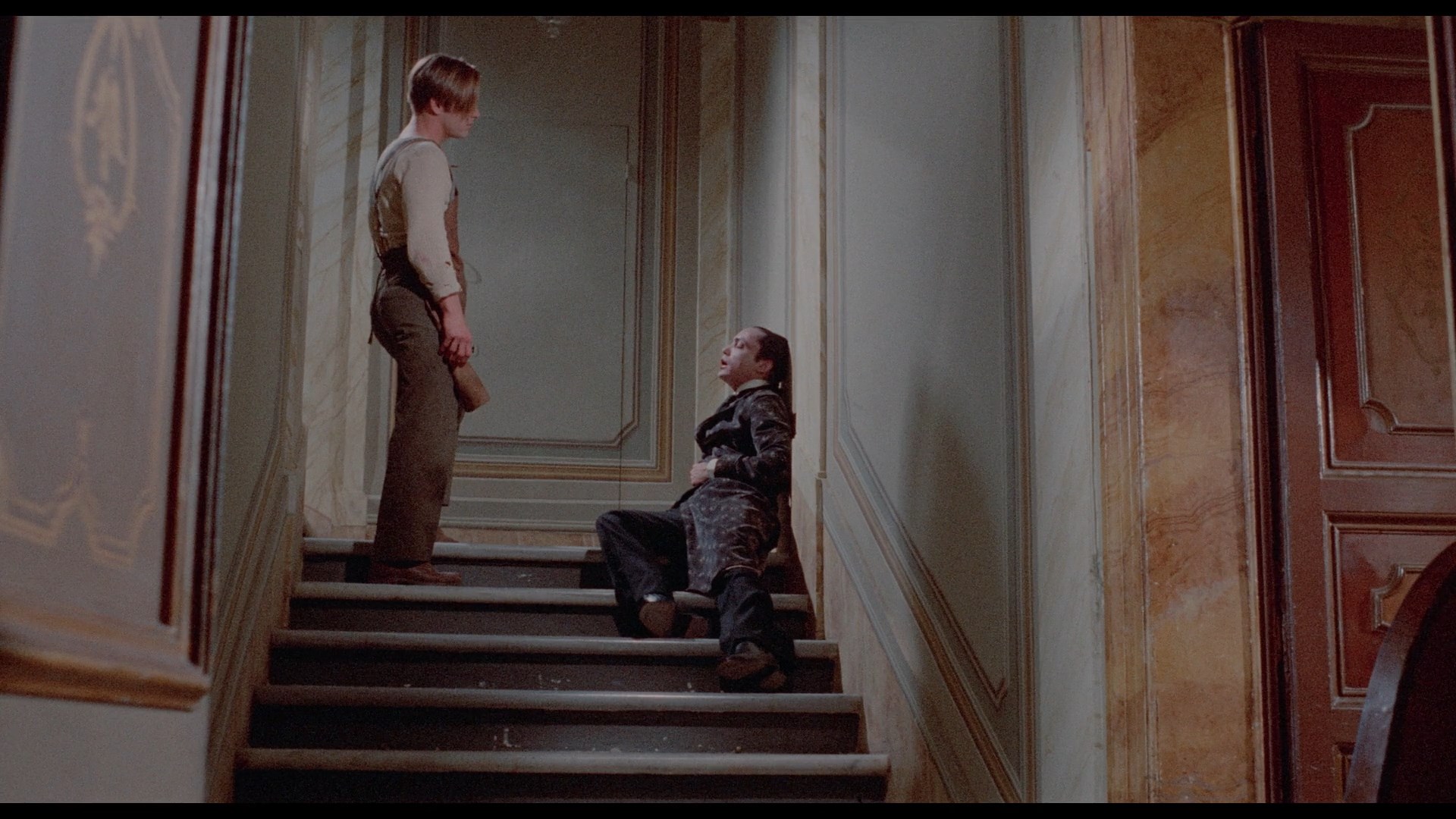 up for "The Blood Of These Whores…" (20m2s), giving a handy and fascinating breakdown of the film as a progression of the work Morrissey had been doing (often confused for Warhol's for obvious promotional reasons), plus the introduction of producer Carlo Ponti, the dizzying nature of all those accents, and the fascinating idea of adapting Cruising that could have prevented this film from being made. Gizzi gets his turn in "Sad, Romantic Dracula" (19m43s), going from his big break with Visconti and going on to work on both Morrissey films as well as the Polanski one made at the same time, all of which made good use of his classical experience. Of course, he's at a piano which means you don't have to wait long before a beautiful live performance on camera. Finally in "The Roman Connection" (23m26s), producer Andrew Braunsberg speaks via Zoom about the indisputable Morrissey authorship of the film, his working relationship with Polanski including Macbeth and the aborted Day of the Dolphin, the arduous nature of shooting in 3-D, the involvement of French producer Jean-Pierre Rassam, his disastrous later reunion with Morrissey on The Hound of the Baskervilles, and his thoughts on the production process of this film. Also included are two English-language trailers (an HD one as Blood for Dracula and an SD one as Andy Warhol's Dracula), plus a little Easter egg in the special features menu (5m16s) with Margheriti himself explaining what he did on both films.
up for "The Blood Of These Whores…" (20m2s), giving a handy and fascinating breakdown of the film as a progression of the work Morrissey had been doing (often confused for Warhol's for obvious promotional reasons), plus the introduction of producer Carlo Ponti, the dizzying nature of all those accents, and the fascinating idea of adapting Cruising that could have prevented this film from being made. Gizzi gets his turn in "Sad, Romantic Dracula" (19m43s), going from his big break with Visconti and going on to work on both Morrissey films as well as the Polanski one made at the same time, all of which made good use of his classical experience. Of course, he's at a piano which means you don't have to wait long before a beautiful live performance on camera. Finally in "The Roman Connection" (23m26s), producer Andrew Braunsberg speaks via Zoom about the indisputable Morrissey authorship of the film, his working relationship with Polanski including Macbeth and the aborted Day of the Dolphin, the arduous nature of shooting in 3-D, the involvement of French producer Jean-Pierre Rassam, his disastrous later reunion with Morrissey on The Hound of the Baskervilles, and his thoughts on the production process of this film. Also included are two English-language trailers (an HD one as Blood for Dracula and an SD one as Andy Warhol's Dracula), plus a little Easter egg in the special features menu (5m16s) with Margheriti himself explaining what he did on both films.
SEVERIN (Blu-ray)
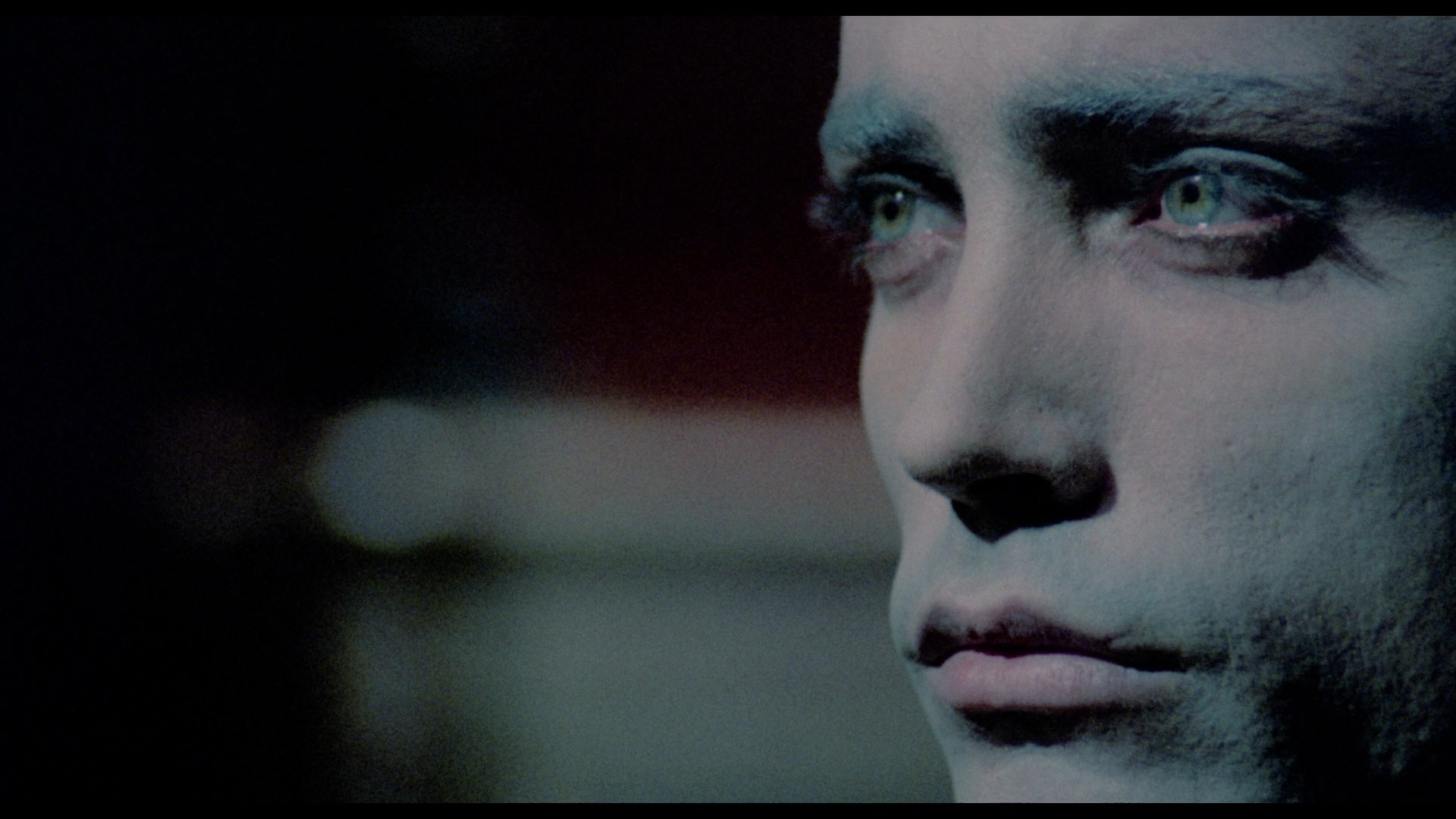
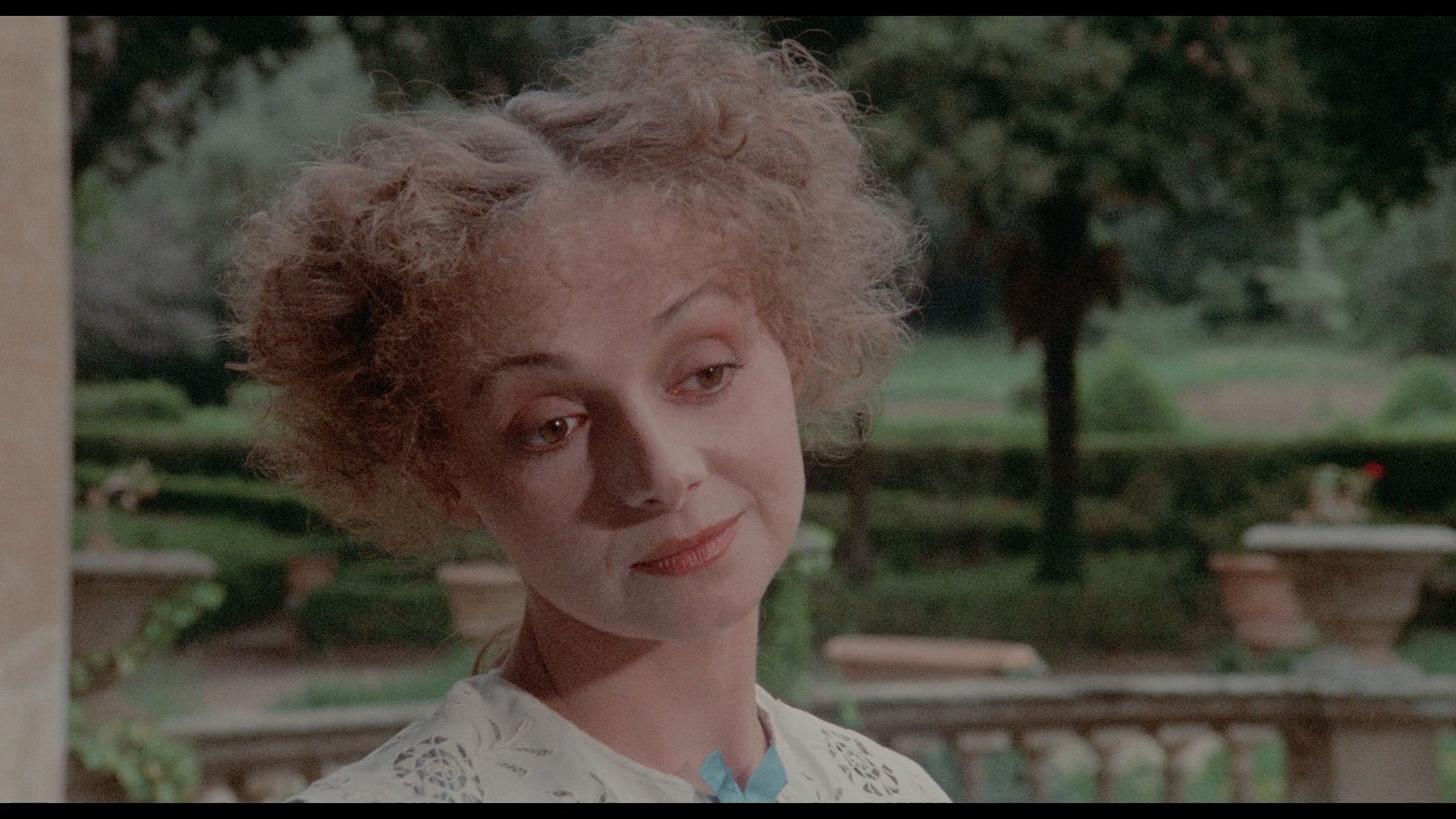
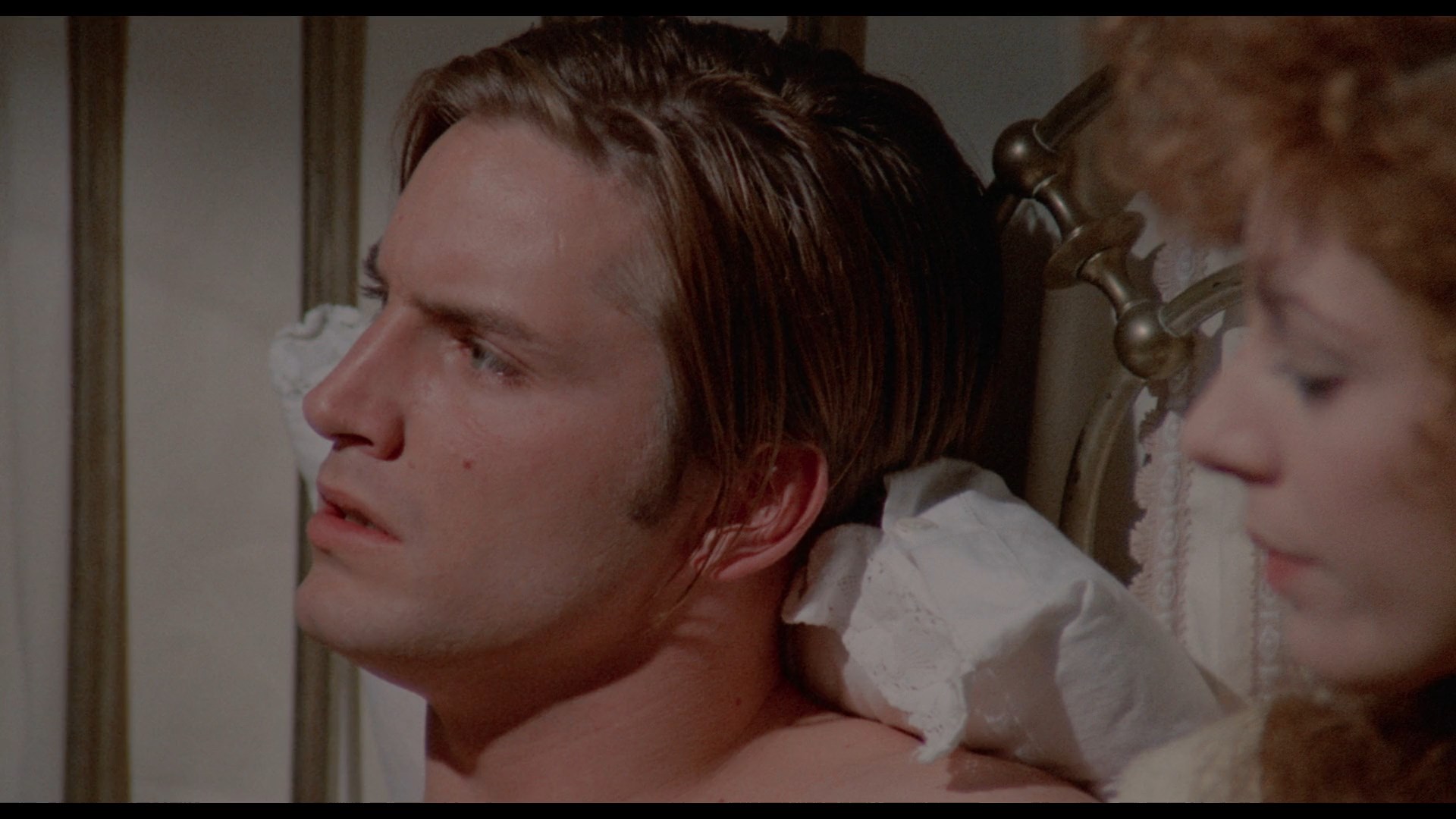
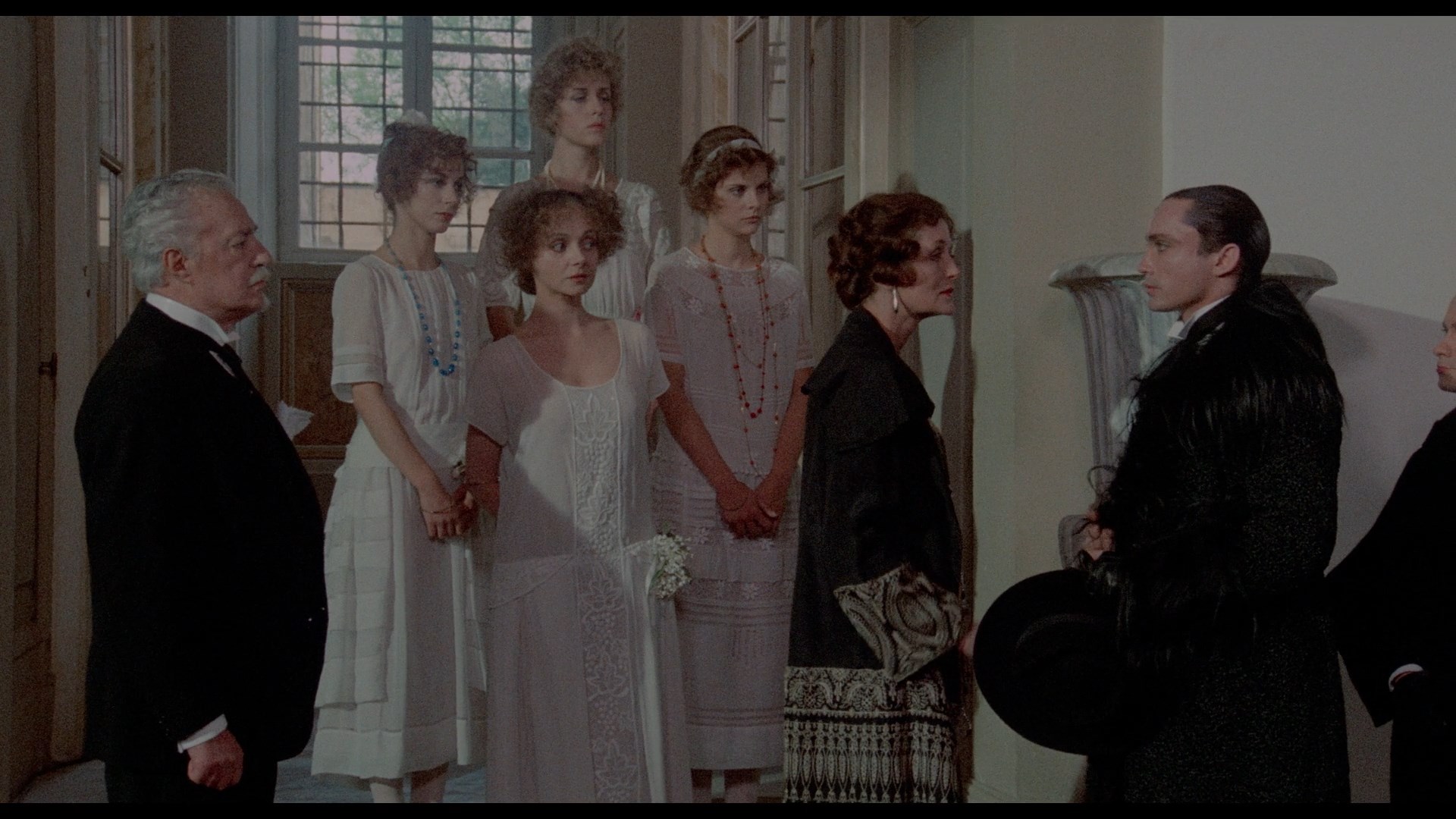
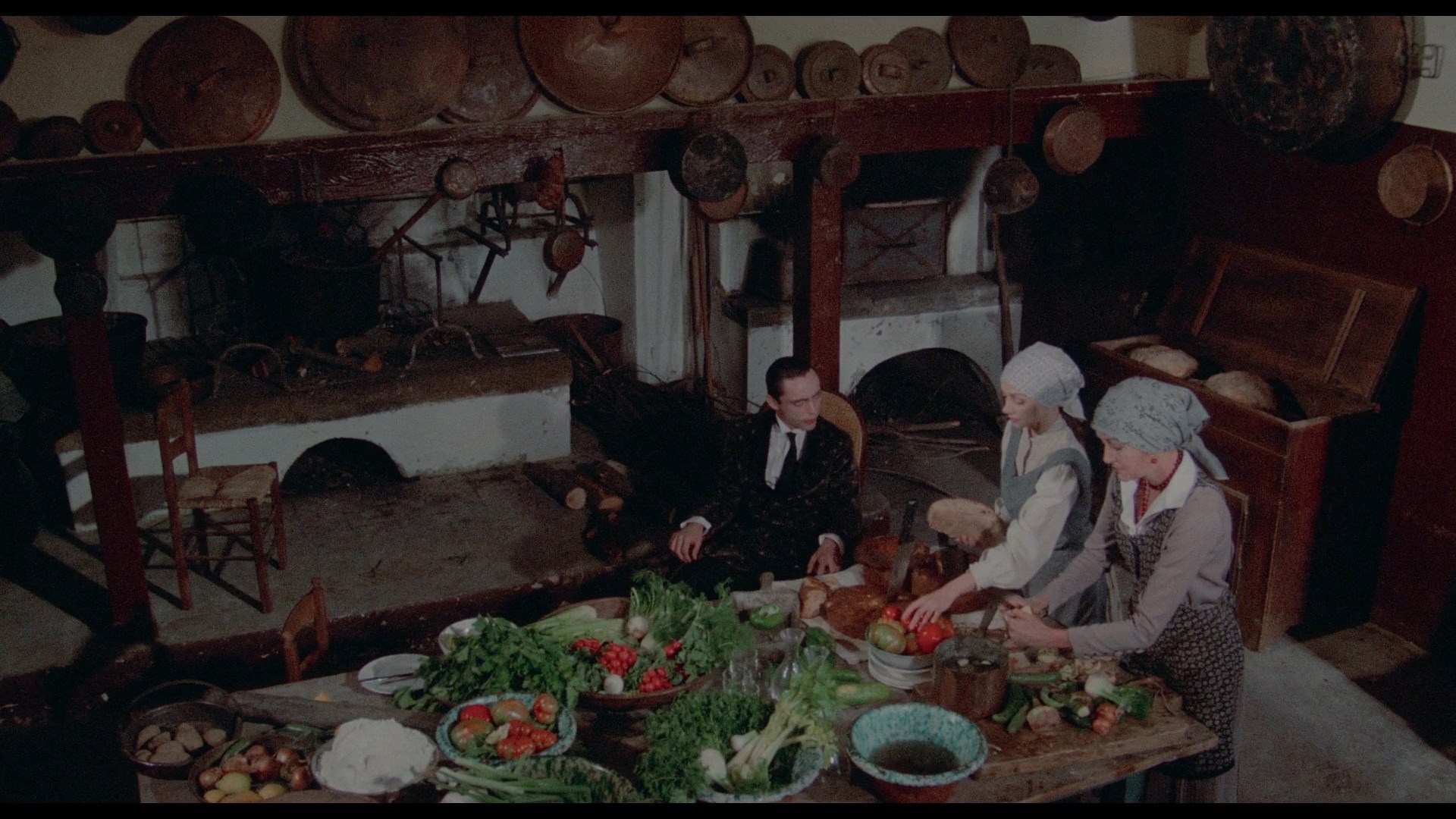
CINEMA CULT (Blu-ray)
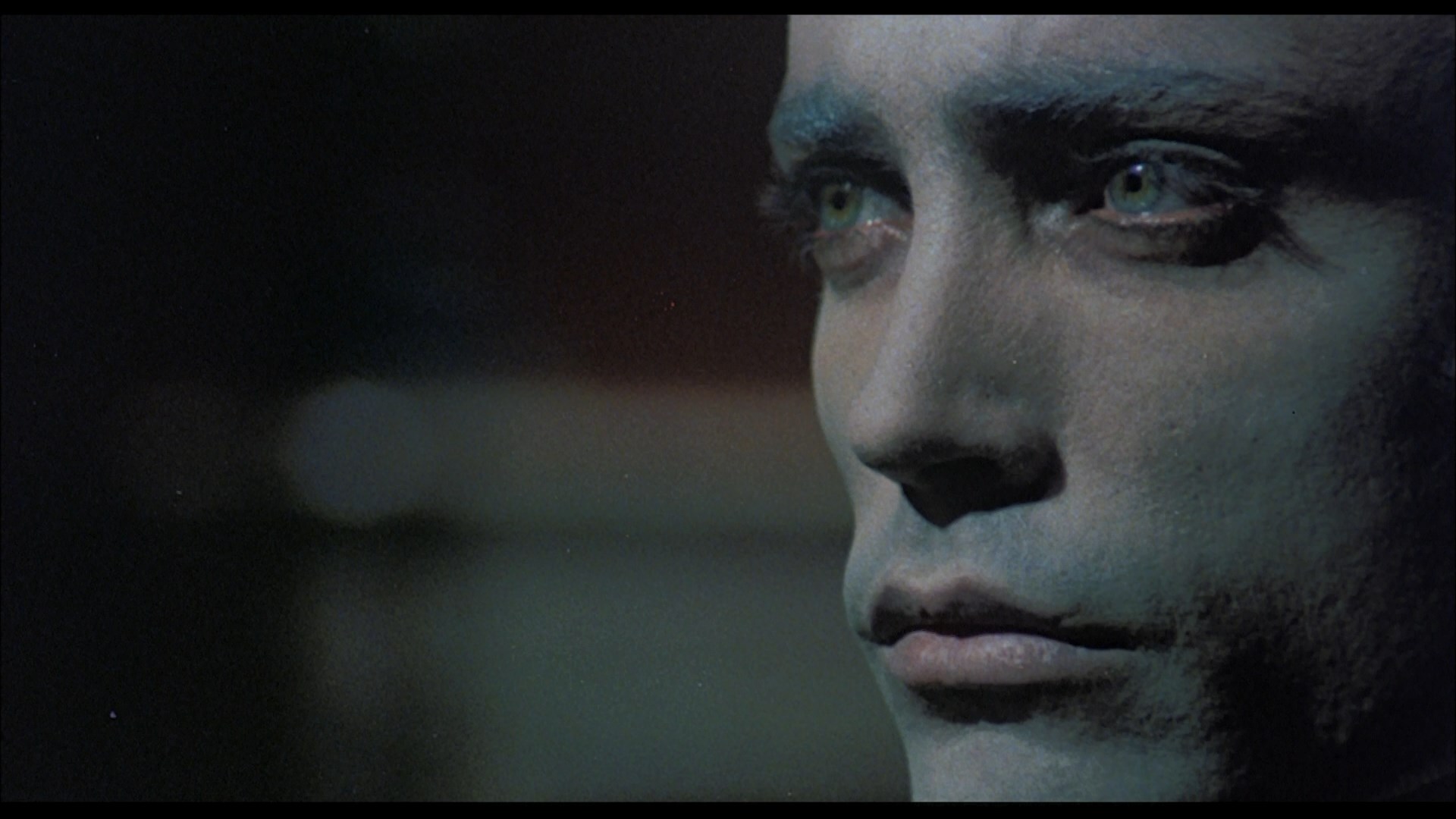
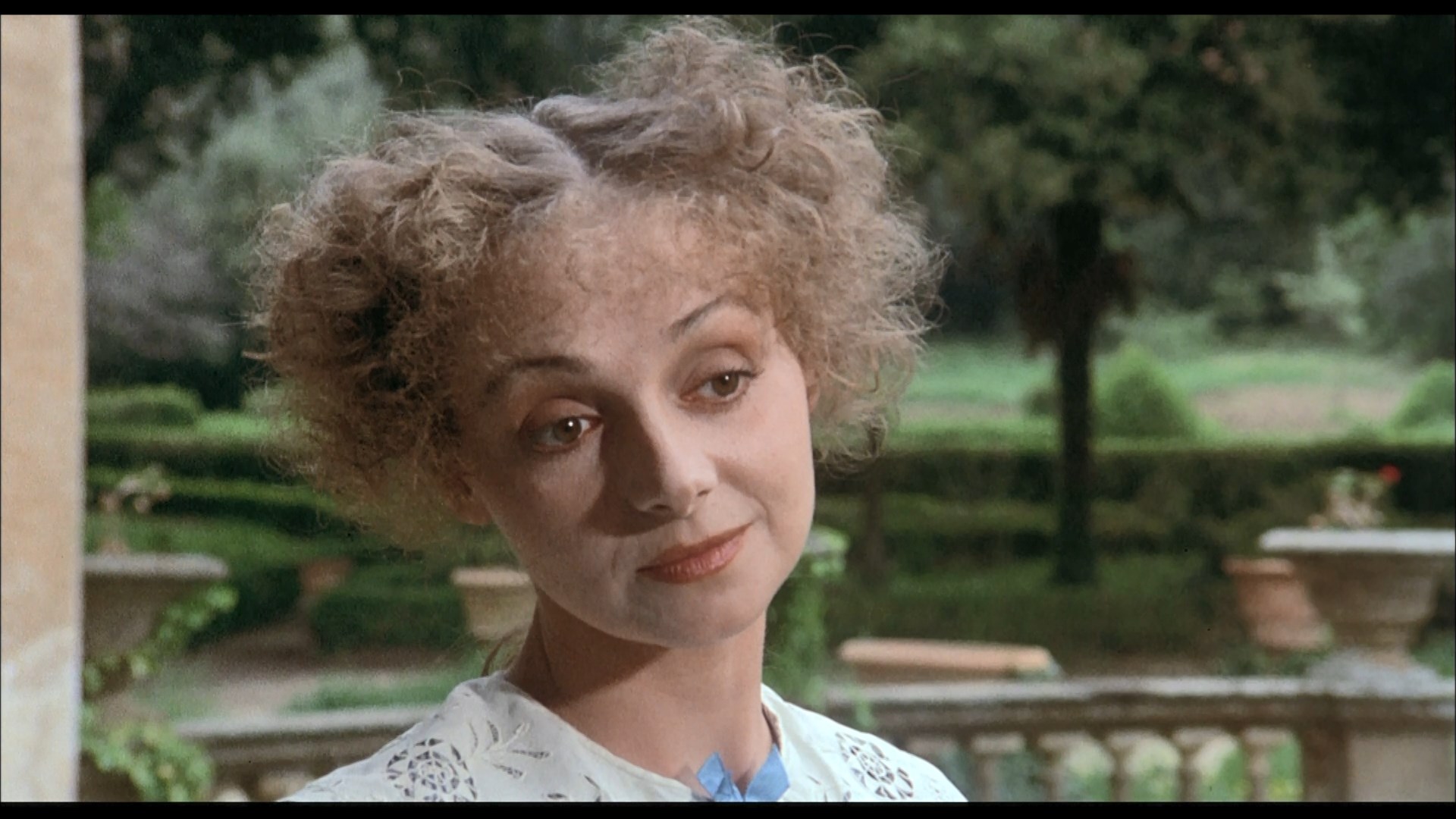
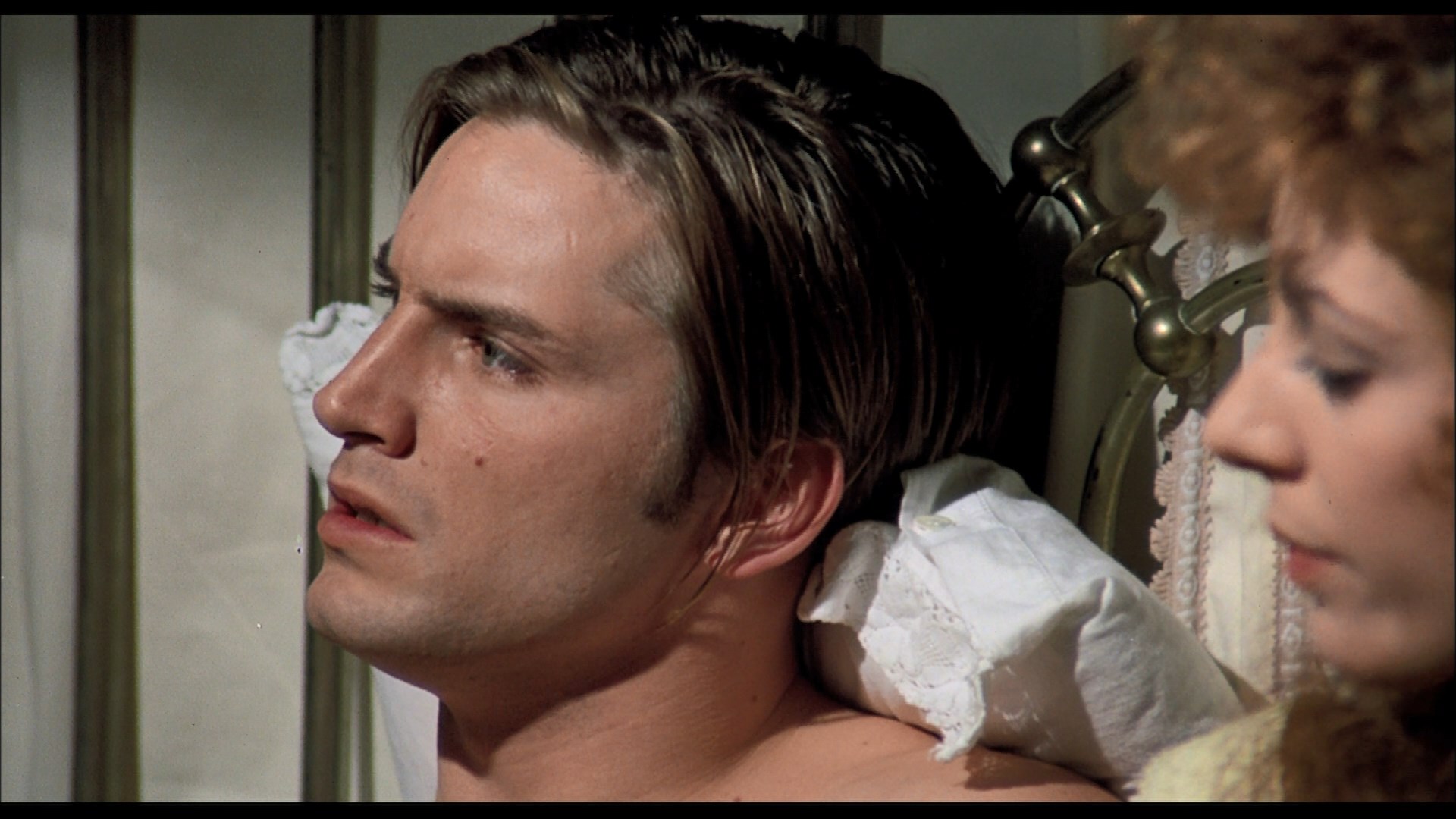
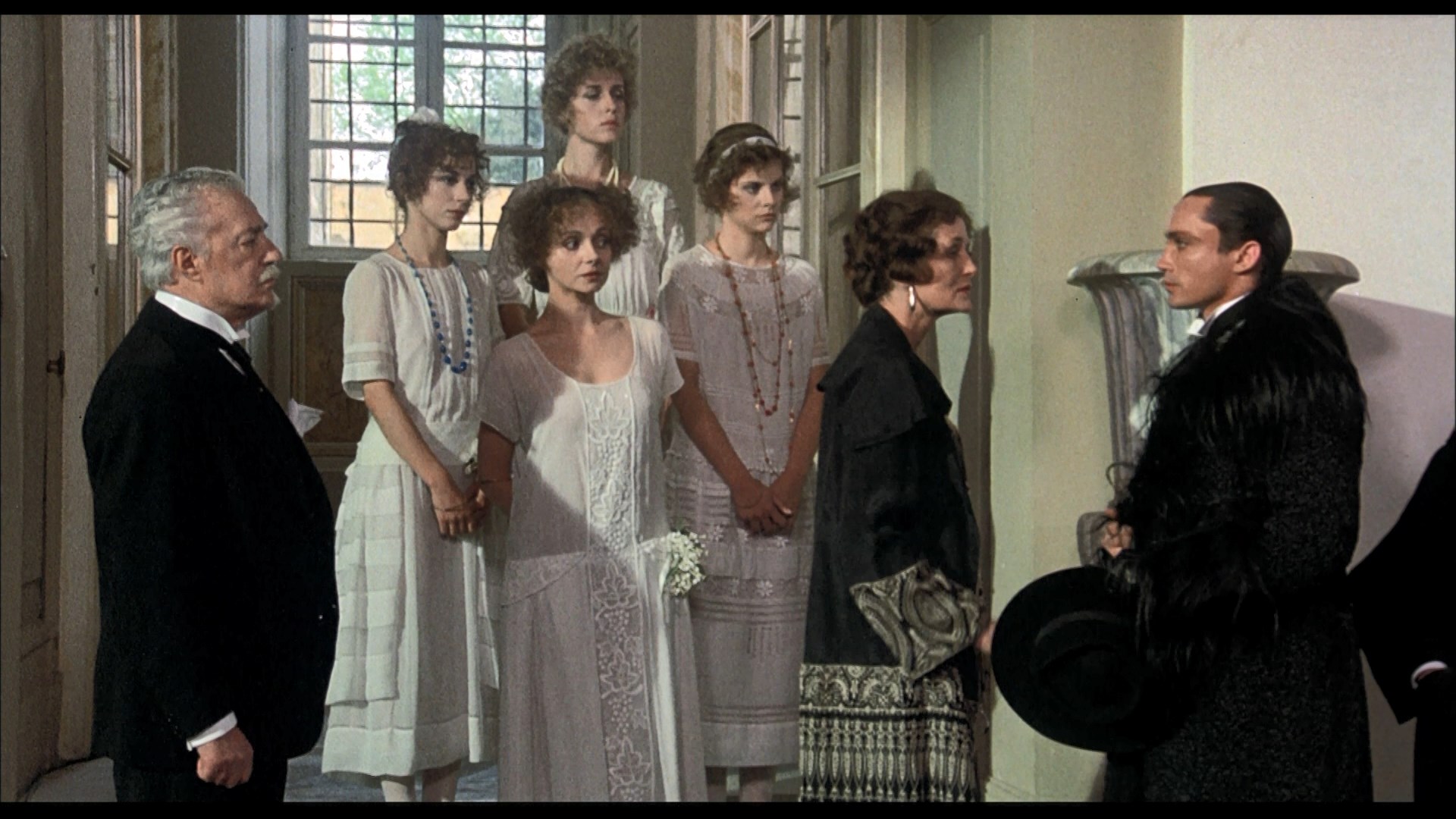
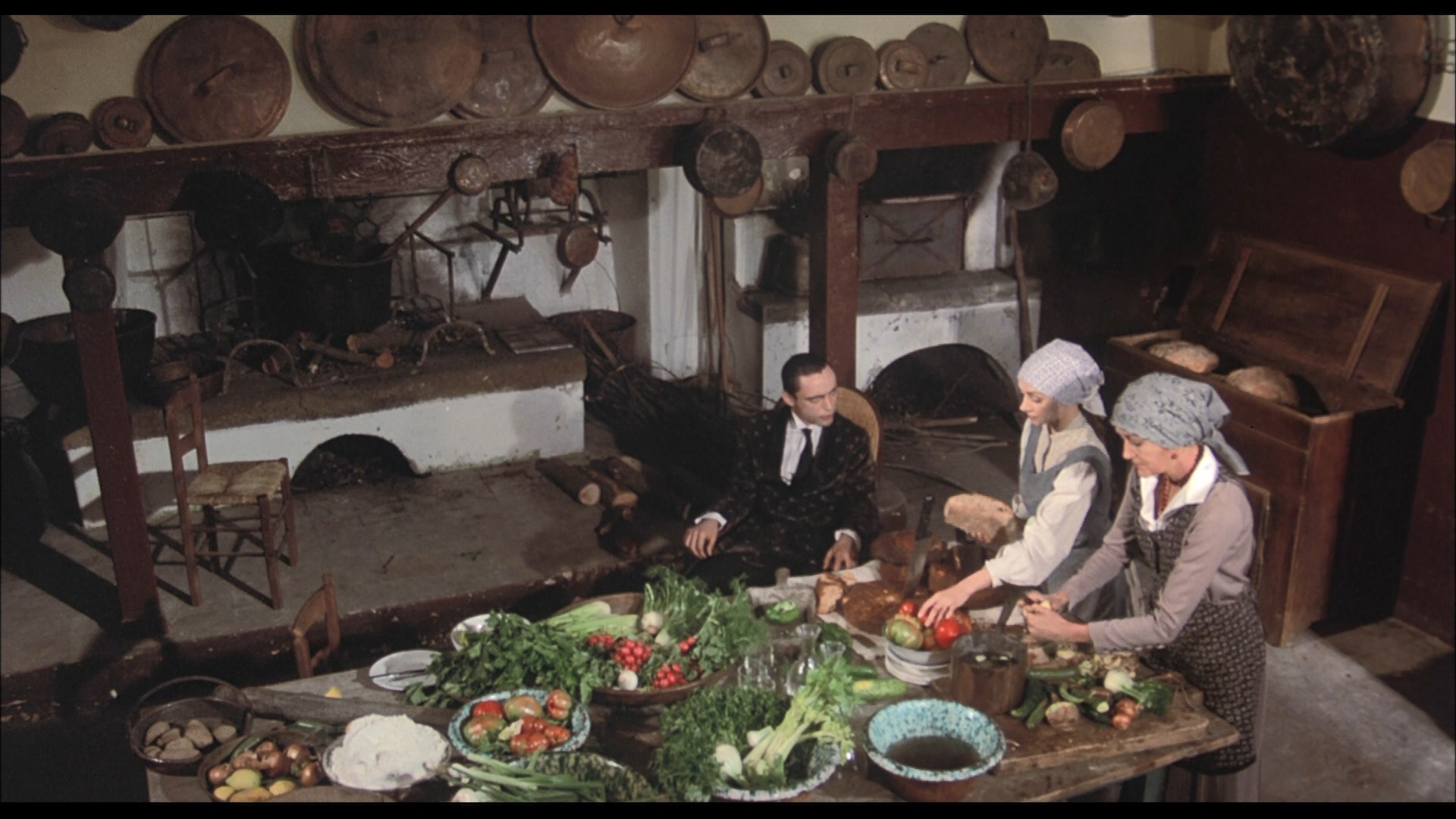
IMAGE ENTERTAINMENT (DVD)
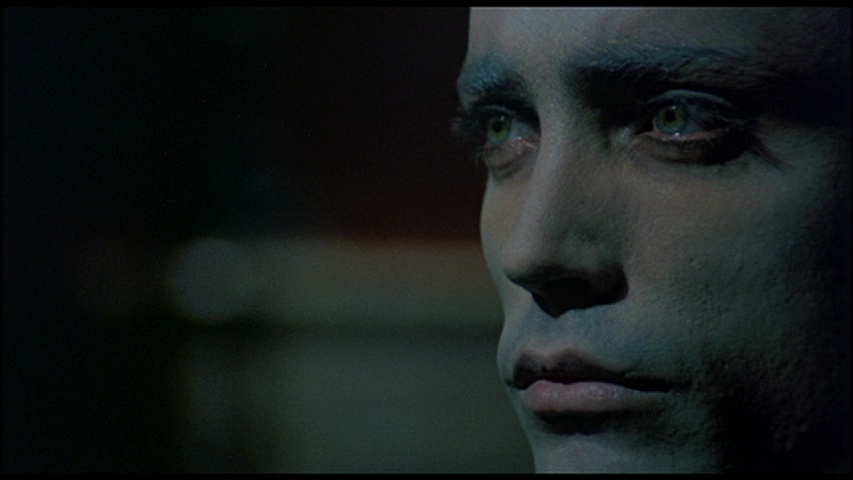
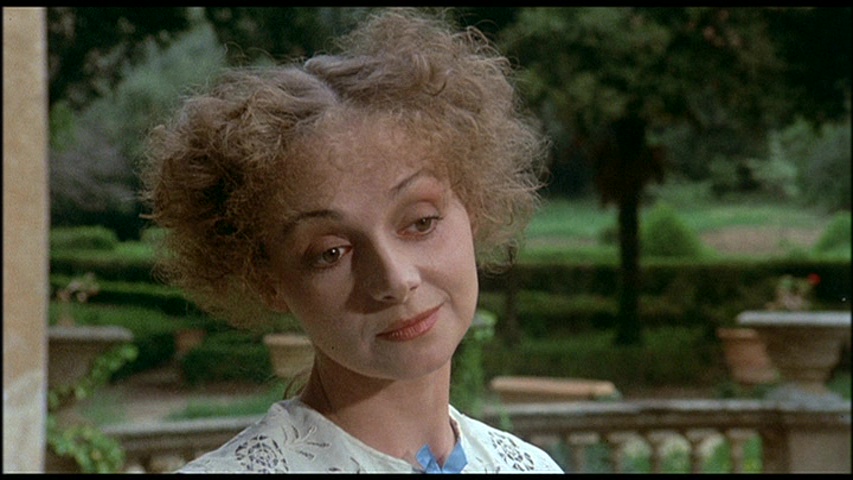
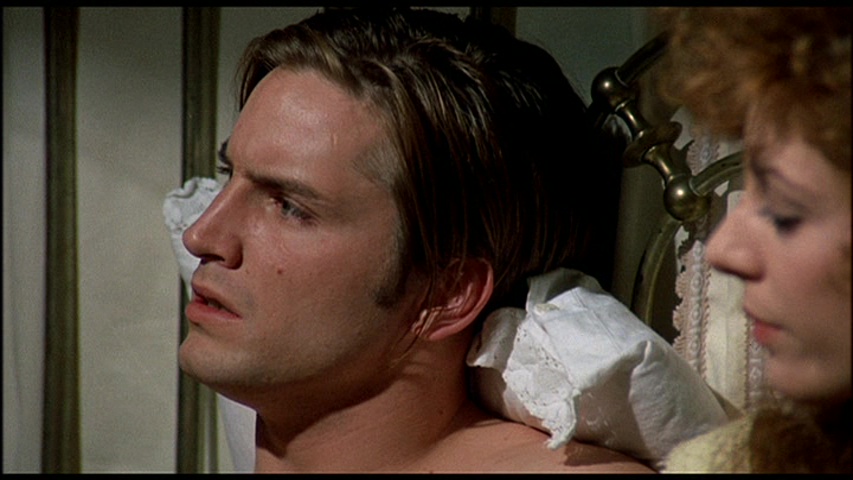
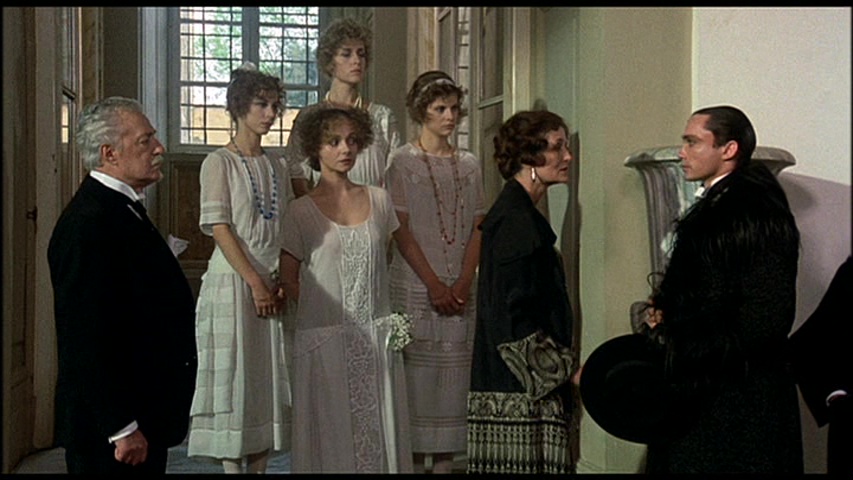
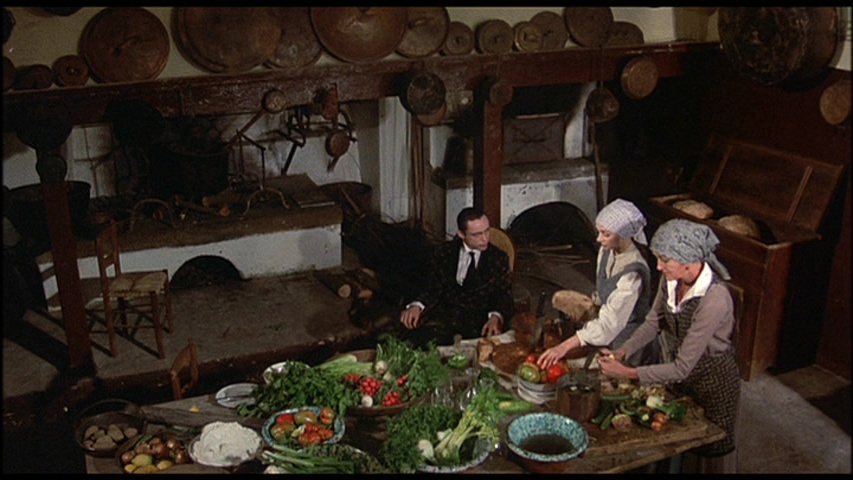
Updated review on June 7, 2022



 had no idea what hit them when they
had no idea what hit them when they  were blindsided by two of the most outrageous cult films of the 1970s, a pair of opulent and hilariously graphic spins on classic movie monsters. The first, Flesh for Frankenstein (released in the U.S. as Andy Warhol's Frankenstein), was a wild 3-D extravaganza of quotable lines and eye-popping innards, so three of its stars stuck around with director Paul Morrissey to jump right into a follow-up film on the spot. Blood for Dracula (originally known as Andy Warhol's Dracula, though Warhol had essentially zilch to do with either film apart from hanging out on the set and taking photos) featured a far more structured and witty script, also shot in Italy and taking full advantage of the locations that one would normally expect in something by Visconti. Like its predecessor, this was released with an X rating in the U.S. (both films have plentiful nudity but aren't sexually explicit); however, its gore level here is more carefully measured, which might sound odd for a film that has several minutes of Udo Kier puking blood into a bathtub. With its insane mishmash of accents and surprisingly potent theme of
were blindsided by two of the most outrageous cult films of the 1970s, a pair of opulent and hilariously graphic spins on classic movie monsters. The first, Flesh for Frankenstein (released in the U.S. as Andy Warhol's Frankenstein), was a wild 3-D extravaganza of quotable lines and eye-popping innards, so three of its stars stuck around with director Paul Morrissey to jump right into a follow-up film on the spot. Blood for Dracula (originally known as Andy Warhol's Dracula, though Warhol had essentially zilch to do with either film apart from hanging out on the set and taking photos) featured a far more structured and witty script, also shot in Italy and taking full advantage of the locations that one would normally expect in something by Visconti. Like its predecessor, this was released with an X rating in the U.S. (both films have plentiful nudity but aren't sexually explicit); however, its gore level here is more carefully measured, which might sound odd for a film that has several minutes of Udo Kier puking blood into a bathtub. With its insane mishmash of accents and surprisingly potent theme of  rotting aristocracy
rotting aristocracy  versus the irate working class, the film became one of the most notable horror films of the decade-- and there's still nothing else out there remotely like it.
versus the irate working class, the film became one of the most notable horror films of the decade-- and there's still nothing else out there remotely like it.  interested in the daughters' blood supply,
interested in the daughters' blood supply,  which turns out to be far more of a challenge than he'd imagined.
which turns out to be far more of a challenge than he'd imagined.  On
On  top of that, the film is still extremely funny, not just in its most-quoted moments like the immortal "The blood of these whooores is killing me!" and the pronunciations of "wergin" but in great throwaway bits like "I am sure they're religious; they have a very nice house" and a great cameo by Roman Polanski (who was shooting What? nearby) and his frequent writer Gerard Brach playing a bar game with Jürging.
top of that, the film is still extremely funny, not just in its most-quoted moments like the immortal "The blood of these whooores is killing me!" and the pronunciations of "wergin" but in great throwaway bits like "I am sure they're religious; they have a very nice house" and a great cameo by Roman Polanski (who was shooting What? nearby) and his frequent writer Gerard Brach playing a bar game with Jürging. An unauthorized Australian release came along later on Blu-ray and DVD from Cinema Cult, porting over the same extra from the Image disc and featuring what appears to be an upscale of
An unauthorized Australian release came along later on Blu-ray and DVD from Cinema Cult, porting over the same extra from the Image disc and featuring what appears to be an upscale of  the same scan.
the same scan. "Blood For Udo" (18m56s), Kier is also in fine form chatting about his quickly truncated melancholy after
"Blood For Udo" (18m56s), Kier is also in fine form chatting about his quickly truncated melancholy after  finishing Frankenstein, the abrupt need to lose ten pounds within a week, the porn movie being shot on the premises at the same time, and some of his other vampire-related roles. (Don't miss the bit about Spermula or his jonesing for a cigarette.) Dallesandro is up next in "Little Big Joe" (28m14s) complete with a whole chronicle of his first encounter with Morrissey (and Warhol) and their early films together (including Lonesome Cowboys and the Flesh trilogy), his return to Morrissey with the two horror films on the heels of The Gardener, and the controversy over the involvement of Antonio Margheriti, who was credited as the director on the Italian releases of both films but was only involved in a limited capacity for second unit work. He also goes into the relationship he forged with Casini on the film and some of the other films he made when he decided to stick around in Italy for a bit.
finishing Frankenstein, the abrupt need to lose ten pounds within a week, the porn movie being shot on the premises at the same time, and some of his other vampire-related roles. (Don't miss the bit about Spermula or his jonesing for a cigarette.) Dallesandro is up next in "Little Big Joe" (28m14s) complete with a whole chronicle of his first encounter with Morrissey (and Warhol) and their early films together (including Lonesome Cowboys and the Flesh trilogy), his return to Morrissey with the two horror films on the heels of The Gardener, and the controversy over the involvement of Antonio Margheriti, who was credited as the director on the Italian releases of both films but was only involved in a limited capacity for second unit work. He also goes into the relationship he forged with Casini on the film and some of the other films he made when he decided to stick around in Italy for a bit.  the villa being used as much as possible. Stephen Thrower turns
the villa being used as much as possible. Stephen Thrower turns  up for "The Blood Of These Whores…" (20m2s), giving a handy and fascinating breakdown of the film as a progression of the work Morrissey had been doing (often confused for Warhol's for obvious promotional reasons), plus the introduction of producer Carlo Ponti, the dizzying nature of all those accents, and the fascinating idea of adapting Cruising that could have prevented this film from being made. Gizzi gets his turn in "Sad, Romantic Dracula" (19m43s), going from his big break with Visconti and going on to work on both Morrissey films as well as the Polanski one made at the same time, all of which made good use of his classical experience. Of course, he's at a piano which means you don't have to wait long before a beautiful live performance on camera. Finally in "The Roman Connection" (23m26s), producer Andrew Braunsberg speaks via Zoom about the indisputable Morrissey authorship of the film, his working relationship with Polanski including Macbeth and the aborted Day of the Dolphin, the arduous nature of shooting in 3-D, the involvement of French producer Jean-Pierre Rassam, his disastrous later reunion with Morrissey on The Hound of the Baskervilles, and his thoughts on the production process of this film. Also included are two English-language trailers (an HD one as Blood for Dracula and an SD one as Andy Warhol's Dracula), plus a little Easter egg in the special features menu (5m16s) with Margheriti himself explaining what he did on both films.
up for "The Blood Of These Whores…" (20m2s), giving a handy and fascinating breakdown of the film as a progression of the work Morrissey had been doing (often confused for Warhol's for obvious promotional reasons), plus the introduction of producer Carlo Ponti, the dizzying nature of all those accents, and the fascinating idea of adapting Cruising that could have prevented this film from being made. Gizzi gets his turn in "Sad, Romantic Dracula" (19m43s), going from his big break with Visconti and going on to work on both Morrissey films as well as the Polanski one made at the same time, all of which made good use of his classical experience. Of course, he's at a piano which means you don't have to wait long before a beautiful live performance on camera. Finally in "The Roman Connection" (23m26s), producer Andrew Braunsberg speaks via Zoom about the indisputable Morrissey authorship of the film, his working relationship with Polanski including Macbeth and the aborted Day of the Dolphin, the arduous nature of shooting in 3-D, the involvement of French producer Jean-Pierre Rassam, his disastrous later reunion with Morrissey on The Hound of the Baskervilles, and his thoughts on the production process of this film. Also included are two English-language trailers (an HD one as Blood for Dracula and an SD one as Andy Warhol's Dracula), plus a little Easter egg in the special features menu (5m16s) with Margheriti himself explaining what he did on both films.![]()